Xingu
- Self-denomination
- Where they are How many
- Linguistic family
The Indigenous Park of the Xingu covers, in its southern part, the cultural area known as the Upper Xingu, which includes the Aweti, Kalapalo, Kamaiurá, Kuikuro, Matipu, Mehinako, Nahukuá, Trumai, Wauja and Yawalapiti . Despite their linguistic diversity, these peoples are characterized by a high degree of similarity in their ways of life and world view.
They are, moreover, interconnected through a network of specialized trade, marriages and inter-village rituals. However, each of these groups makes a point of cultivating its own ethnic identity and, if the ceremonial and economic exchange celebrates upper Xinguan society, it also celebrates the differences among these societies.
The other ethnic groups who inhabit the Park – the Ikpeng, Kaiabi, Kisêdjê, Tapayuna and Yudja – are not a part of this complex and are culturally quite heterogeneous. They were integrated to the borders of the demarcated area by administrative order, which in some cases meant their removal from their villages.
The 16 ethnic groups who inhabit the Park: Aweti, Ikpeng, Kaiabi, Kalapalo, Kamaiurá, Kĩsêdjê, Kuikuro, Matipu, Mehinako, Nahukuá, Naruvotu, Wauja, Tapayuna, Trumai, Yudja, Yawalapiti.
Languages: Kamaiurá e Kaiabi (Tupi-Guarani family); Yudjá (Juruna family); Aweti (Aweti family, Tupi Trunk); Mehinako, Wauja e Yawalapiti (Aruak family); Kalapalo, Ikpeng, Kuikuro, Matipu, Nahukwá e Naruvotu (Karib family); Kĩsêdjê e Tapayuna (Jê family, Jê Trunk); Trumai
There are, however, frequent marriages among these groups, which results in a greater articulation among them.
A recent movement has made all the peoples of the Xingu come together in the name of common interests. The indigenous organizations (above all the Indigenous Land Association of the Xingu) has been established as an important means for dialogue with the national society and encouragement of projects in education, economic alternatives and protection of the territory.
This section consists of a general introduction to the Park and the Upper Xingu, complementing the set of texts which deal specifically with each people.
Contact
Ahira, the Mehinako Association at Indigenous Park of the Xingu - http://www.ahira.org/
Ikpeng People Site - http://www.ikpeng.orgLanguages
Despite the intense exchange among different peoples of the Park, each maintains its own language. The following language families are represented in the Park:
- Tupi-Guarani family (of the Tupi trunk): Kamayurá and Kaiabi
- Juruna family(of the Tupi trunk): Yudjá (or Juruna)
- Aweti family (of the Tupi trunk and with only one language): Aweti
- Arawak family: Mehinako, Wauja and Yawalapiti
- Karib family: Ikpeng, Kalapalo, Kuikuro, Matipu and Nahukwá
- Jê family(of the Macro-Jê trunk): Suyá
- Language not classified in any family: Trumai
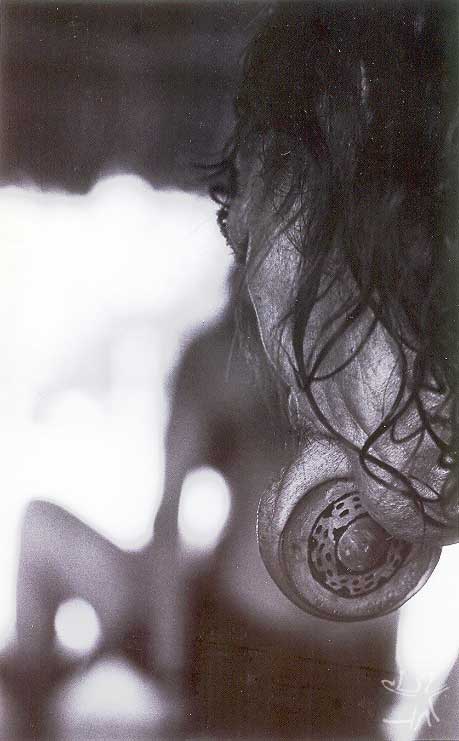
Portuguese is used as a contact language among the different ethnic groups, being spoken more fluently by the young men and adults. In recent times, the number of Portuguese speakers has been increasing and many young women are beginning to speak and understand the language. These days, with the large number of roads connecting the Xingu Park to the cities and ranches, many Indians circulate in the area around the Park, using the Portuguese language for commercial transactions and other forms of relationship with the regional population. Through television, which is present in nearly all the villages, they also learn Portuguese. Moreover, in the schools the indigenous teachers teach them to speak and write in Portuguese, although all classes are given in the native languages.
As far as the ability to speak more than one indigenous language, among the peoples of the Upper Xingu it is common that people understand the languages of their neighbors, even if they don’t know how to speak it, such that Indians of different groups occasionally have dialogues in which each one speaks his/her own language. Among the Kaiabi, Suyá and Yudjá there is also mutual comprehension, due to their living together in the same region and to intermarriages. Besides that, in all the villages of the Park, children and young people born of interethnic marriages customarily are fluent in the languages of both their parents. And there are young people who speak four or even five languages.
The Park
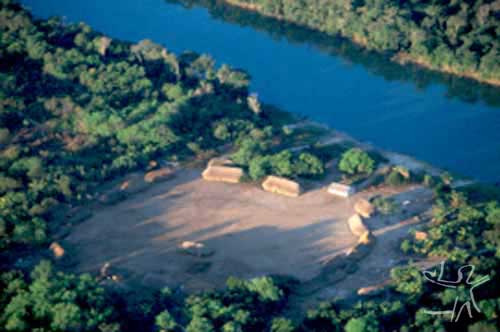
The Indigenous Park of the Xingu (PIX) is located in the northeastern part of the State of Mato Grosso, in the southern part of the Brazilian Amazon. Over its 2,642,003 hectares, the local landscape displays a great biodiversity, in a region of ecological transition, from the savannas and dryer, semideciduous forests to the south to the Amazonian ombrophyllous forest to the north, including dense forests, fields, floodland forests, terra firme forests, and forests on archaeological black earth. The climate alternates between a rainy season, from November to April, when the rivers are high and the fish scarce, and a period of drought in the other months, the time of the tracajá turtle and the great inter-village ceremonies.
To the south of the Park are the feeder rivers of the Xingu, which make up a basin comprised of the Von den Steinen, Jatobá, Ronuro, Batovi, Kurisevo and Kuluene rivers; the first being the principal feeder river of the Xingu, where it meets with the Batovi-Ronuro.
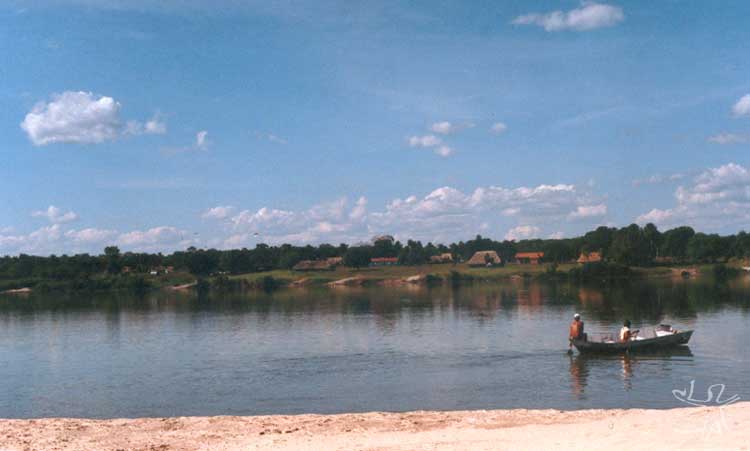
The administrative demarcation of the Park was ratified in 1961, with an area that overlapped with the Mato Grosso municipalities of Canarana, Paranatinga, São Félix do Araguaia, São José do Xingu, Gaúcha do Norte, Feliz Natal, Querência, União do Sul, Nova Ubiratã and Marcelândia.The idea of creating the Park took shape during a roundtable discussion organized by the Vice-President of the Republic in 1952, out of which a pre-project was formulated for a Park which was much larger than what finally was created. Although the legislative and executive powers of Mato Grosso were represented in this discussion, as well as the governor of the state, the state began to concede lands inside the perimeter of the area destined for the Park, to colonizing companies. Thus, when the Xingu National Park was finally created, by Decree nº 50.455, of April 14, 1961, signed by President Jânio Quadros, its area corresponded to only a quarter of the surface area initially proposed. The Park was regulated by Decree nº 51.084, of July 31,1961; adjustments were made on it by Decrees nº 63.082, of August 6,1968, and nº 68.909, of July 13,1971, and the demarcation of the actual perimeter was finally done in 1978.
The hybrid category of “National Park” was due to the twin objectives of protecting the environment and the indigenous populations which guided its creation, the Park being an area which was subordinate to both the official indigenist agency and the environmental agency. It was only with the creation of the Funai (in 1967, substituting the SPI – Indian Protection Service) that the “National Park” came to be designated as an “Indigenous Park”, thus going back to its original objective of protecting native sociodiversity.
Taking into account the peoples who live there, one can divide the Indigenous Park of the Xingu in three parts: one to the north (known as the Lower Xingu), one in the central region (the so-called Middle Xingu) and another to the south (the Upper Xingu). In the southern part are the feeder rivers of the Xingu; the central region of the Morená (where the Ronuro, Batovi and Kuluene rivers converge, identified by the peoples of the Upper Xingu as the place of creation of the world and beginning of the Xingu) to (Big Island) Ilha Grande; following the course of the Xingu, one gets to the northern part of the Park (the map to the left indicates the location of all the villages and posts).
In the south, covering the culture area of the Upper Xingu, the peoples there are culturally very similar, and receive assistance from the Leonardo Villas Boas Indigenous Post. On the Middle Xingu, there are the Trumai, the Ikpeng and the Kaiabi, who receive assistance from the Pavuru Post. To the north are the Suyá, Yudjá and Kaiabi, assisted by the Diauarum Post. Each Post provides for the logistics of projects and activities developed in the Park, such as education and health; on all of them there is a UBS (Basic Health Unit), where indigenous health agents and employees of the Unifesp (Federal University of São Paulo), work together, through an accord with the National Health Foundation. There are yet eleven Vigilance Posts on the borders of the territory, on the banks of the main feeder rivers of the Xingu.
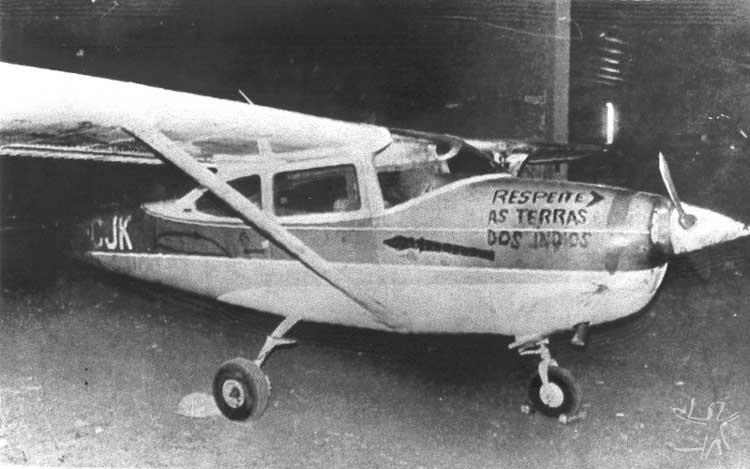
In the 1980s, the first invasions by hunters and fishermen took place in the territory of the Park. At the end of the 1990s, the forest fires on cattle ranches located to the northeast of the Park threatened to affect the Park and the advance of lumbermen to the west began to approach the physical borders defined by the demarcation. Moreover, the occupation of the area around the Park began to pollute the headwaters of the rivers which supply water to the Park and which lie outside the demarcated area. In this process, there has been an ever-increasing perception among the inhabitants of the Park that what is on its way is an uncomfortable “embrace”: the Park is being surrounded by a process of occupation in the area surrounding it and it is already looking like an “island” of forests in the midst of pasture and intensive agriculture in the region of the Xingu.
Among the actual problems confronted by the inhabitants of the Park, the greatest perhaps result from this process of predatory occupation in the area surrounding the Park. The “area surrounding the Park” covers the region of the state of Mato Grosso which extends around the principal feeder rivers of the Xingu, from their headwaters. Running parallel to the Xingu, two major highways function as axes for occupation: to the west of the Park, the Cuiabá-Santarém (BR-163) highway; and to the east, BR-158. Under these adverse regional conditions, the natural resources and the sociodiversity of the Park are threatened along the nearly 900 kilometers of its perimeter.
During the 1990s, the Indians’ concerns over these threats stimulated a significant number of new territorial lawsuits. Two of these, which the Indians won, resulted in the Wawi and Batovi Indigenous Lands, of the Suyá and the Wauja respectively, which were ratified in 1998. With these new areas, the total land area of the Park became 2,797,491 hectares.
Continuing with this process, the Ikpeng have been organizing to regain part of their traditional territory in the region of the Jatobá River, which was left outside the demarcated area. The Wauja are also negotiating for the region called Kamukuaká, which is considered sacred and is located on a ranch next to the Park, and which they would like to see transformed into an area of environmental preservation.
The question of monitoring the territory is most certainly high on the list of political questions in the Park, being discussed both in meetings of leaders and assemblies of the Atix (Xingu Indigenous Land Association) and in meetings with the Funai and federal and state environmental agencies (Ibama and the State Environmental Foundation - Fema). Towards these ends, an infra-structure of the eleven vigilance posts mentioned above has been set up to protect the areas that allow direct access to the Park, such as the intersection of the main rivers with the borders of the Park and the point where highway BR-080 borders on these limits.
Nevertheless, the system of posts in itself is not sufficient to confront the situations created by the area surrounding the Park and is thus being complemented by other actions, being developed in the context of the Borders Project, coordinated through a partnership between the Atix and ISA. The project includes the mapping of the advance of deforestation, through satellite photos, and the identification in locus of new vectors of occupation in the area surrounding the Park. It also includes a training program for the Heads of the Posts, the restoration and maintenance of the boundary marks that establish the physical limits of the territory and a geo-referenced databank of all the ranchers whose properties border on the Park. This work makes it possible for the Indians to follow the situation up close as to what is happening inside the borders of the Park and mobilize their communities against external threats, both in inter-village discussions, and with the public agencies responsible (Funai, Ibama and the state government).
Population
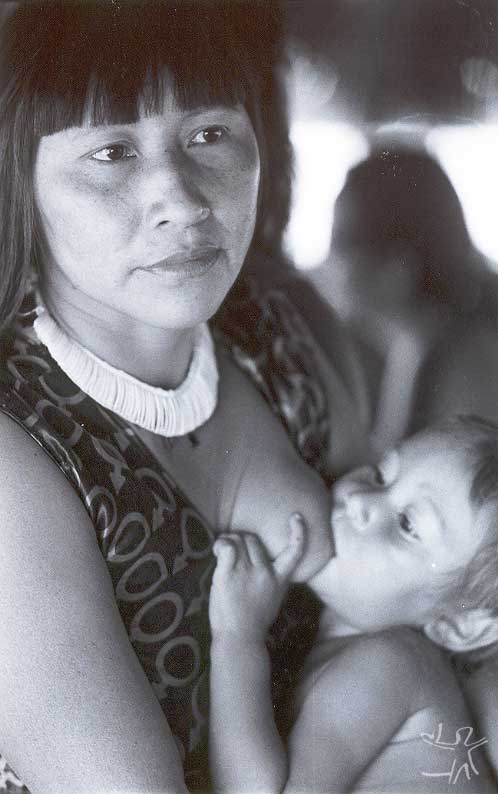
The task of obtaining a population total of the Park for all the ethnic groups in one year was recently made possible, thanks to the work developed by the Unifesp (Federal University of São Paulo) in the area of health, through an agreement with the Funasa (National Health Foundation). In the past, the censuses or population estimates were made on the basis of researchers’ itineraries. Given these limitations, in order to get an idea of the demographic evolution of the Upper Xingu, the table below was prepared, which is divided into three columns (the first two being based on the research by Pedro Agostinho, 1972). The first sets of data go back to the end of the XIXth Century and are found in the texts by Karl von den Steinen, but they refer to only a few people. The numbers marked by asterisks indicate that they were obtained by estimated calculation, supposing that the villages had the same number of houses and residents per house.
The second column corresponds to estimates by different researchers who were in the region in the middle of the XXth Century. For the year 1954, when a measles epidemic devastated the region, the data indicate the initial population, the number of deaths which occurred in that year and the surviving population. The following column presents the data of 2002 (based on the Unifesp survey), which demonstrate a significant demographic recovery.
| Ethnic groups | End of the XIXth Century | Middle of the XXth Century | 2002 |
| Aweti | 80* (1924)
27 (1947-8)
27 (1952)
31-8=23 (1954)
36 (1963) |
||
| Kalapalo | 180-25=155 (1946)
150 (1948)
150-40=110 (1954)
100 (1963)
115 (1970) |
||
| Kamaiurá | 216/264* (1887) | 198/242* (1938)
110 (1948)
112-18=94 (1954)
115 (1963)
118 (1965)
119 (1969)
118 (1970) |
|
| Kuikuro | 140 (1948)
148 (1952)
145 (1954)
139-9=130 (1954)
118 (1963)
150 (1970) |
||
| Matipu | 16 (1948)
27-9=18 (1954)51 'added to the Nahukwá' (1963) |
||
| Mehinako |
At the most 308* (1887) |
56 (1949)
68 (1962)
55 (1963)
78 (1970) |
|
| Nahukwá | 18 ou 28 (1948)
17 (1953)51 'added to the Matipu' (1963) |
||
| Trumai |
More than 43* (1884) |
43 (1938)
18 ou 25 (1948)
21-2=19 (1954)
21 + dispersed (1963)
26 (1966)
25 (1970) |
|
| Wauja | 171/228* (1887) | 95/96 (1948)
78 (1954)86 (1963) |
|
| Yawalapiti | '28 'dispersed (1948)
'12 + 'dispersed (1951)
25 (1954)
41 (1963)
41 (1965)
65 (1970) |
For the ethnic groups who lived more to the north of the Park, the following are population data from 2002 (also based on the Unifesp survey):
| Ethnic groups | 2002 |
| Ikpeng | 319 |
| Kaiabi | 745 |
| Yudjá | 248 |
| Suyá | 334 |
From the first expedition to the creation of the Park
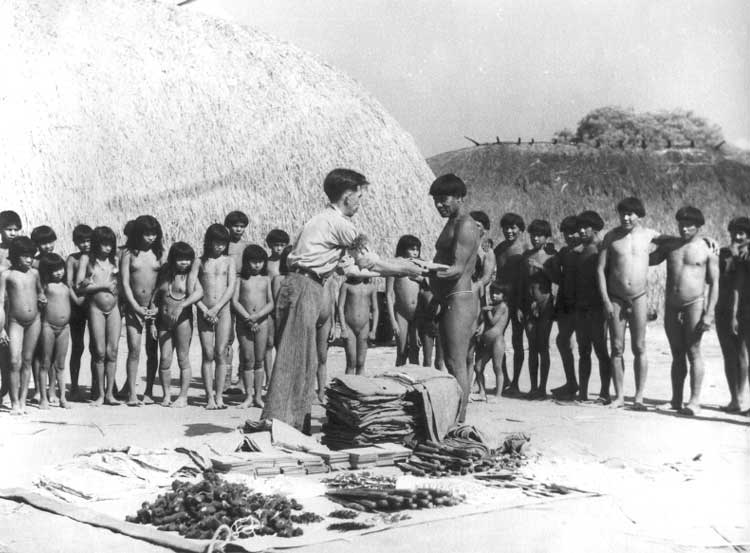
The Indians who inhabit the Park have a history of contact with the non-indigenous society which is peculiar in comparison with most of the other Indians in Brazil, since they had an ethnologist as their principal mediator of contact (Karl von den Steinen), instead of slave-hunting expeditions, ranchers, goldpanners or missionaries. Moreover, they weren’t assisted directly by the SPI (Indian Protection Service), but by the Central Brazil Foundation, represented by the Villas Bôas brothers. And, in the case of the Upper Xingu, long before contact, they developed an interethnic complex of rituals and specialized trade, creating strong links amongst themselves which made it difficult for the cultural universe of the Whites to penetrate.
The two expeditions of the German ethnologist Karl von den Steinen, in 1884 and 1887, made the whites aware of the existence of the indigenous peoples of this region. Starting from Cuiabá and crossing the Paranatinga river, in the Xingu-Tapajós watershed, the team reached the Bakairi of Paranatinga and made brief contact with the Suyá in the first voyage. In the second, the team went up the Kurisevo and stayed awhile among the peoples of the Upper Xingu.
After Von den Steinen, several explorers made visits to the region such as Hermann Meyer (who published several written works about his trip in 1897, 1898, 1900), Hintermann (1925), Petrillo (1932) and Max Schmidt (1942). These expeditions stimulated the Indians’ desire for metal tools (such as knives, scissors, axes) as well as spread contagious diseases among the Xingu peoples.
In general, the peoples who inhabited the region more to the south of the present-day Park have not moved from their location very much since the time of Von den Steinen, with the exception of the Bakairi and the Trumai, not to mention those groups who became extinct since then: the Kustenau, Naravute, Tsuva and Aipatsé. The Bakairi served as guides for the first ethnographic expeditions, and for that reason they are held responsible by the upper Xingu peoples for the introduction of diseases and are accused of witchcraft. Besides that, the Bakairi, who lived in at least eight villages in the Xingu basin, began looking for metal tools among members of their people living outside the basin, such as those who lived to the southeast (on the Paranatinga River). They progressively began settling with them, also being stimulated to do so by the SPI with the creation of a post in 1920, such that by 1923 they had withdrawn totally from the area of the feeder rivers of the Xingu (Cf. Barros, 2001).
The Trumai, occupied the territory between the feeder rivers of the Xingu and the region on the banks of this river, which left them vulnerable to repeated attacks by groups who inhabited these áreas, such as the Suyá and the Ikpeng. The ethnographer Karl Von den Steinen found them already quite weakened in 1884. After occupying several different locations, during an agitated history, today they have four villages located midway between the Leonardo Villas-Bôas and Diauarum posts.
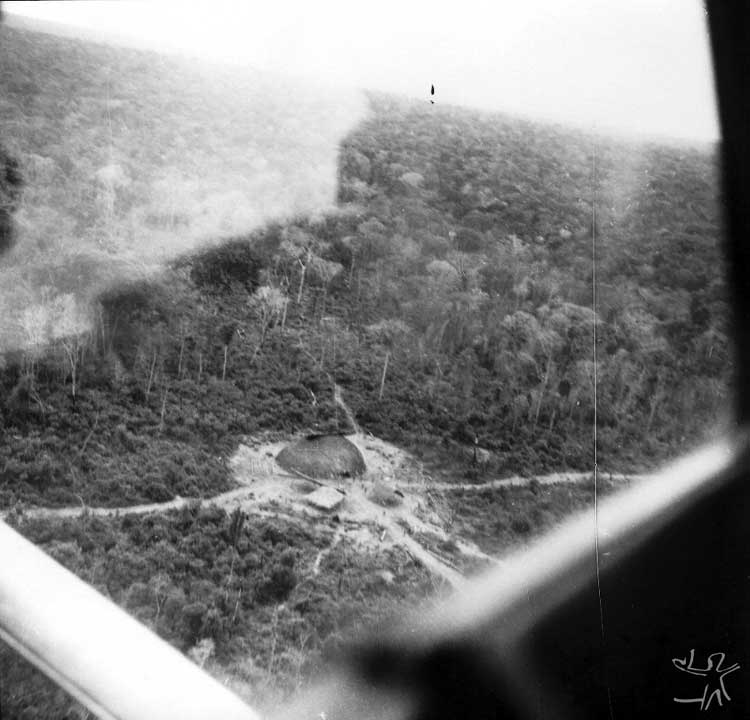
The area to the north of the Park, in turn, fell within the radius of action of the Suyá, who had their villages on the Suiá-missu River, right bank tributary of the Xingu. The Yudjá, coming from the north also began to settle on it (Von den Steinen, in his descent of the Xingu in 1884, found them in Pará, on the stretch between the von Martius and the Piranhaquara Rapids). It is probable that the Yudjá had been moving for more than two centuries from the banks of the Amazon, from which they withdrew due to the pressures and persecutions of the colonizers at the end of the XIXth Century.
In the first half of the XXth Century, the peoples of the Xingu continued to be reached only by land, from the south. It was also in the south that the Indians went to look for iron instruments, at the post set up on the Paranatinga. Research expeditions were scarce, but it was from this period that the first study of a specific people from the Uppper Xingu, the Trumai, was done. They were visited by the ethnographer Buell Quain in 1938, although he never finished his research; after his death, his data were analyzed and published by Robert Murphy.
In this period, the Suyá suffered setbacks which drastically reduced their population. The Yudjá, sometimes allies, sometimes adversaries, armed by a rubber-boss, attacked a Suyá village sometime after 1915. Awhile later, during a pequi gathering expedition in the place where the Diauarum Post is located today, the Suyá suffered an attack by the Menkrãgnoti, from which only a few men escaped, who remained practically without any women. In their search for marriage partners, the Suyá then attacked the Wauja, but they suffered retaliation from these people, who organized an expedition against them, with the help of the Mehinako, Trumai and Kamaiurá.
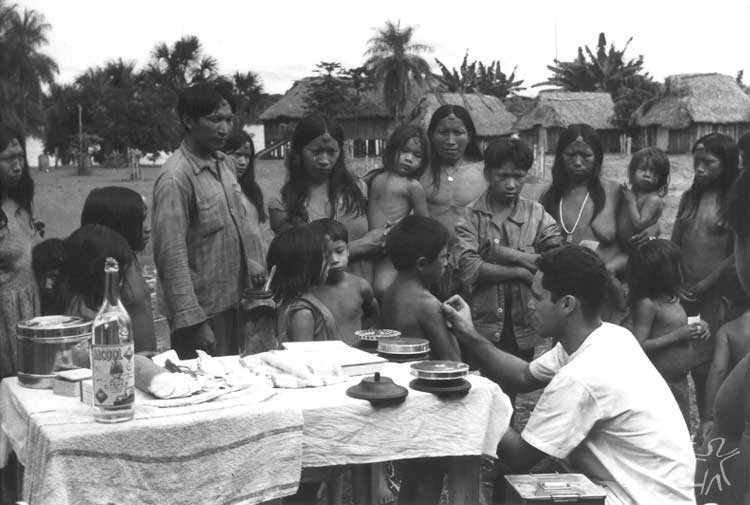
In 1946, the FBC (Central Brazil Foundation), product of the “March to the West” promoted by the regime of the New State, began to establish itself in the region, thus initiating the era of the Villas Bôas brothers. For Cláudio, Leonardo and Orlando Villas Bôas, the peoples of the Xingu represented "Indians of pure culture”[i.e., unacculturated], who should be preserved from the economic expansion fronts that were already becoming evident in the region. In this sense, they began, with the support of Marechal Rondon, the medical doctor Noel Nutels, and the anthropologist Darcy Ribeiro, among others, but with strong opposition from the government and the ranchers of Mato Grosso, a campaign for the demarcation of the local indigenous lands.
In this period, a Brazilian Air Force base was built in Jacaré, on the Kuluene River, between the mouth of the Kurisevo and the Batovi. The first airstrips were opened in the area of the feeder rivers of the Xingu and researchers, employees of the FBC, medical doctors, filmmakers, and other agents of contact started to come into the area by planes of the National Airmail Service. The access route by land, which passed through the Post of Paranatinga, lost its importance. Anthropologists of the National Museum, such as Eduardo Galvão and Pedro Lima, resumed ethnological research. Foreign ethnologists also came back to research in the area, such as Robert Carneiro and Gertrude Dole among the Kuikuro.
Ironically, despite the facilities that were being created, in 1954 there was an outbreak of measles that affected all the villages of the upper Xingu, causing the deaths of 114 people. Out of the approximately 3,000 people of the upper Xingu in the time of von den Steinen, the population dropped to one of its lowest points: 574 people. Despite efforts to improve the health situation, conditions continued to be precarious, such that the upper Xingu population reached its lowest level in 1965, when there were only 542 people (Cf. Heckenberger, 2001).
If the region had until then been occupied by Indians who migrated, not exactly in a spontaneous way, but rather forced by the adverse circumstances in their regions of origin, now they were sought out in the neighboring areas and transferred to the Park, if they were thought to represent an obstacle to the opening of roads and to colonization. This was what happened with the Kaiabi, Ikpeng, Panará and Tapayuna, all of whom were settled in the northern part of the Park.
The Kaiabi lived in the region bathed by the upper courses of the feeder rivers of the Tapajós: the Juruena and the Teles Pires. On the Juruena, they were on the Upper Arinos and its tributary, the river of Fish; on the Teles Pires, they were on the upper course of this river and on its tributary, the Green River. Heavily pressured by different expansion fronts since the last decades of the XIXth Century, such as rubber extraction, goldpanning and agricultural colonists, they became strangers on their own lands and their population decreased. Having entered into contact with the employees of the FBC, which advanced in the direction of their territory by way of the Manitsauá-missu River and which provided them with good health care, part of the Kaiabi accepted the invitation to be transferred to the Park. Their transferal took place on several occasions in 1955, 1966 and 1970, and their agricultural production began supplying the Diauarum and Leonardo posts. The Catholic missionaries of Diamantino, however, were against the migration of the Kaiabi to the Xingu. Thus, a part of the group stayed on their original lands, which made the recognition of a Kaiabi Indigenous Land possible.
The Ikpeng (also known as Txikão) are presumed to have belonged to a larger ethnic group which included the Arara Indians. Taking a southerly direction, they would have emerged on the Iriri River, tributary of the Lower Xingu in the first half of the XIXth Century. They later lived in the Teles Pires basin, near the Kaiabi, Panará and Apiaká. At the end of the XIXth Century, they reached the Batovi River, attacking the Wauja, Nahukwá and Mehinako. They also reached the Paranatinga and Novo rivers, staying near the Bakairi.
In 1960, the Wauja and their allies attacked the Ikpeng with firearms and killed twelve men. Besides that, half the Ikpeng population died in a flu epidemic. The survivors fled to the upper Jatobá River, tributary of the Ronuro, where the Villas Bôas brothers found them in 1964. Confronted by the penetration of goldpanners in this territory, they accepted being transferred to the Park in 1967. Taken to the Leonardo Post, they married with the Wauja, Kamayurá and Mehinako. In 1979, they built their own village in the central part of the Park, between the Trumai and the Kaiabi.
Two other peoples, the Tapaiuna and Panará (both of the Jê language family), were also brought by backwoodsmen to the interior of the Park, but, after a few years, they decided to leave. The Panará recovered part of their traditional territory, ratified as the Paraná Indigenous Land, and the Tapayuna moved in 1987 to the Metyktire and Kremoro villages, of the Metyktire people, on the Capoto/Jarina Indigenous Land, where they stayed.
Since the creation of the Park in 1961, Orlando Villas Bôas was director for 17 years, establishing a program of medical assistance for the Indians through an accord with the Federal University of São Paulo (Unifesp), which exists up to the present day. He also took a series of measures which sought to prevent by all means contact between the inhabitants of the Xingu Park and the outside world, a controversial policy which led to accusations from various sectors that he was being excessively paternalistic, especially with the transferal of the Kayabi, Ikpeng, Tapayuna and Panará peoples to the Park, as though this represented the only option for their future.
The establishment of the indigenous post as a mediator of the relations among the villages had complex repercussions, as it imposed a fixed centre on a decentralized system. It discouraged hostilities between the peoples of the Upper Xingu and the ethnic groups to the north of the Park, becoming a political reference point. But it also interfered in the internal power structure of the villages, by promoting a new social category: a person who mediated between the group and the post (and the Whites in general, since the post also assumed the position of a center for “redistribution” of visitors). Those who came to occupy this role did not necessarily coincide with the leaders of the villages. There was thus a tendency to duplicate positions of control and mediation, and the village/post mediators received more support from the administration of the Park, for they had a greater command of the Portuguese language and greater facility at adapting to new conditions, among other factors (Cf. Castro, 1977).
In any case, the administration of the FBC made it possible to provide a different kind of assistance than that provided to other indigenous peoples in Brazil, guided by a strong personal component and supported by the prestige that it had earned from the national society, in being able to maintain the Park relatively isolated from the influences that customarily and bruskly alter indigenous cultures and from the invasions that put them in a situation of dependency. It thus promoted a posture of greater respect from the rest of the society towards the Indians of the Xingu, in contrast with what has occurred in other parts of the country and the world.
History prior to the first expeditions
As the research by Michael Heckenberger (2001) has demonstrated, the prehistory of the Upper Xingu can be pushed back to the end of the first millenium of the Christian era. In the period between the years 800 and 1400 a population established itself there, and left behind certain vestiges of its culture, such as a characteristic form of ceramics and circular villages, which indicates the ancestors of the present day Arawakans of the Xingu, who would have migrated there from the west.
Between 1400 and 1600, large fortified villages were built, surrounded by ditches (up to 2.5 meters in length, 15 in width and 3 in depth), which covered a surface area of from 25 to 50 hectares, with earthworks to the side of the central plaza and radial trails, giving the impression, from the distribution of the black earth, that the population was denser in the center than on the periphery. It is worth remembering that earthworks are characteristic of the Arawak peoples in other regions of the continent. At the end of this period, the presence of a population with a different culture becomes evident, in an area more to the east, on the right bank of the Kuluene (or Xingu), which the oral tradition of the present day Karib-speaking peoples of the Xingu recognizes as being their ancestors. In convergence with this hypothesis, the ethnologist Robert Carneiro (2001) relates a Kuikuro myth referring to the origin of Lake Tahununu, on the banks of which they guarantee they inhabited. The dwelling-places were clearly different from the present pattern, consisting of one or two large circular malocas; as was the manner of producing ceramics different.
The period between 1600 and 1750 begins with the indirect effects of the European presence on the continent, on the indigenous inhabitants of the Upper Xingu, and ends with their face-to-face confrontation with the slave-hunting expeditions. Subsequently, the Arawak fortifications are weakened. At that time, the Tupi ancestors of the Kamayurá and Aweti arrive in the area.
The period from 1750 to 1884 begins with the so-called bandeirante incursions [slave-hunting expeditions] and ends with the first visit by Karl von den Steinen. An account by a Kuikuro chief (Atahulu) to the linguist Bruna Franchetto in the year 2000 (Franchetto, 2001) presents this period in a very suggestive way, focusing on the massacres which resulted from the bandeirante incursions, followed by a phase in which the Whites gave back the few indigenous prisoners that they had taken with them and even gave them presents, and, finally the arrival of Kálusi, that is, Carlos (Karl von den Steinen). In this period, the Trumai and the Bakairi moved closer to the upper Xingu, consolidating the upper Xingu multi-ethnic system, as well as other peoples, such as the Suyá and Ikpeng, who had remained peripheral to this system.
Village and society
On the Upper Xingu, the villages are formed by communal houses arranged on an oval-shaped perimeter, around a central plaza of beaten ground. In the center of this plaza, there is the so-called mens’ house. Besides serving as a place for the men’s meetings, the building also hides the sacred flutes, which are prohibited for the women to see, and which for that reason are played inside the house or at night on the plaza, when the women have gone to sleep.
The center of the Plaza is also the place where the dead are buried, where the rituals are held, where the ceremonial payments are made, where the chief receives messengers from other groups and makes his speeches to the local group; it is also there that the men hold the wrestling matches (huka huka, described in the section The long ritual of the Kwarup) among members of different villages during all formal meetings.
The houses are covered with sapé thatch. The domestic group of each dwelling is generally comprised of a nucleus of brothers and their respective families, to which are added parallel cousins and occasional ascending generation kin. The leader of this domestic group is the so-called “owner of the house", who is responsible for coordinating productive activities and other daily tasks that involve the participation of the residents.
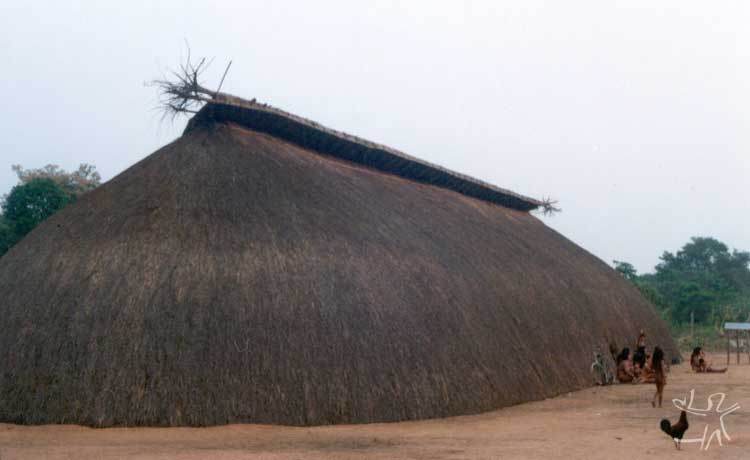
Ideally, the residence rules prescribe that, in the first years of marriage, the husband must reside in the house of his wife’s parents, paying through his services for the concession of their daughter. Once this period has been fulfilled, in general the married couple goes to live in the husband’s house of origin. Exceptions to this rule include the “owners of the house", the leader of the village or those already married with another woman. In these situations, from the beginning the woman goes to live in her husband’s house, and payment is made in goods. Preferential marriage is, ideally, between cross-cousins. The connection between the houses is established through the alliances solidified by marriages and the common support to the leader of the village.
The internal space of the house has no divisions, except for the compartments where adolescents in puberty seclusion stay, or married couples with newborn children or widow/-ers in mourning. The formation of the person on the Upper Xingu implies such periods of seclusion. In the case of the men, they then systematically receive teachings on the techniques of male labor and huka-huka wrestling during their puberty seclusion. The more prolonged the seclusion, the greater the social responsibilities and leadership which must be assumed in the community. In this period, sex should be avoided so that the young man can become a good wrestler.
At her first menstruation, the young girl is put in seclusion, during which time she learns how to perform female tasks in the preparation of food and the manufacture of artwork. During her seclusion, which customarily does not last more than a year, she does not cut her hair and her bangs grow over her eyes. At the end, she receives a new name and is considered an adult, ready for marriage.
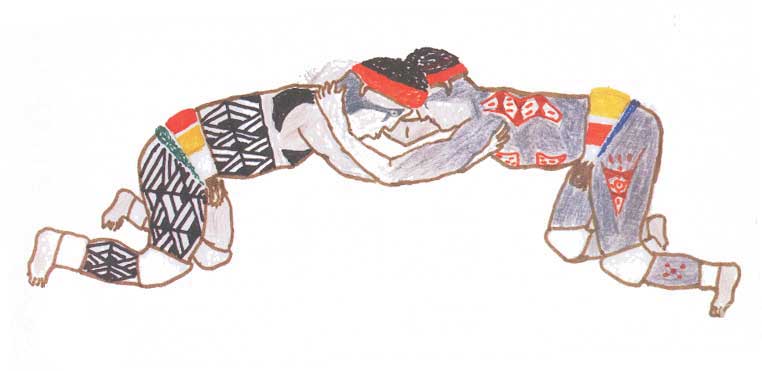
The political unit par excelence on the Upper Xingu is the village, the leader of which acts as a mediator and regulator of conflicts, who must demonstrate generosity and capacity in maintaining the internal harmony of the group. The power of the chief, which is of a markedly peaceful nature, depends on the approval of the group, above all the support of the leaders of domestic groups. The chief’s political skill is expressed through his words, his speeches and counsel presented on the plaza. The rules of succession to the status of leader of the village are flexible and customarily generate much competition over the post.
The “owner of the house” is, in the final analysis, the one who takes the initiative to build the house. Ideally, his firstborn son should succeed him. The main attributes of the owner of the house involve the transmission of requests from the leader of the village to his domestic group in relation to daily tasks, which he also coordinates.

Inside the house, the minimum unit, in spatial terms, is a married couple with unmarried children; the hammocks of this unit define distinct virtual territories, centered around the hearth (which is opposed to the communal fire used for the making of manioc bread, in the center), and each family generally uses the same housepost to tie up the inside ends of their hammocks. The central space is set aside for circulation. There are two doors, which open onto the major axis of the house, one facing the plaza, the other facing the outside of the village. It is near these doors that those who need light to perform some activity sit, because the inside of the houses is very dark.
Each house forms a unit of economic cooperation which is relatively independent of the others, especially in the case of female activities (in this regard, see the item "productive activities.”) At nightfall, after all activities have ceased, families customarily stay at the doors of their houses, conversing, mutually handling each other’s bodies (removing hair, combing hair, removing lice etc.). The young men generally paint and decorate themselves. The older men smoke and chat in the men’s house. Early in the night, everyone begins to retire and the nuclear families get together around their respective hearths, where they eat the last meal and after, go to sleep.
Due to their cultural specificities, life in the village and the social organization of the other peoples of the Park are presented on their respective pages: Ikpeng, Kaiabi, Kisêdjê e Yudjá.
Homogeneity and cultural diversity
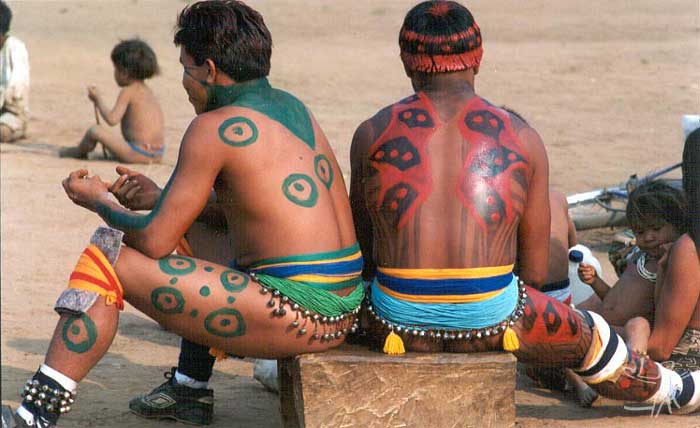
The cultural similarity among the peoples of the Upper Xingu, cultivated by trading, marriages, and intergroup rituals, is also present in a series of other aspects, such as the predominance of fish as a source of protein over meat and the same ideal of behavior which places a high value on generosity (the willingness to give) and self-restraint in temperament.
Beyond the specializations of each of the peoples, there are items produced in all of the villages of the Upper Xingu, such as zoomorphic benches which are sculpted out of a single piece of wood; the dart-throwers for use in the Jawari ritual; the use of the uluri, a female piece of clothing consisting of a small triangle of liber placed over the púbis and tied to the waist with a string of buriti fibre; the hair cut short and oval-shaped for the men and worn long with bangs for the women; the same body ornaments and painting; the composition of circular villages, with large oval malocas, a harpy-eagle cage and house of the sacred flutes (prohibited to the women) on the central plaza. This uniformity, however, is not complete: the languages are different, there are cultural peculiarities which differentiate each people and, above all, the identity of each ethnic group is cultivated in such a way as not be diluted into the society of the upper Xingu.
It is mainly when they are contrasted with the peoples to the north of the Park that the homogeneity of the upper Xingu takes on more definite shapes, since from the time they came to the region, these ethnic groups have maintained hostile or friendly contact with the Upper Xingu, but never actually were part of the same socio-politico-ritual system with them. The peoples of the upper Xingu, in turn, have set aside a separate place in their cosmologies for these groups, putting them into the category of “wild Indians”.
There exists, however, an effort at articulation among all the peoples who dwell in the Park to discuss common problems, and which has as a mediating agent the Atix (Indigenous Land Association of the Xingu), which organizes meetings of leaders of all the ethnic groups (in this regard, see the item indigenous associations)
Productive activities

Fish, manioc bread and porridges (the latter two being made from the processing of bitter manioc) are the principal items of the diet of the peoples in the southern part of the Park. The ethnic groups of the northern and central regions eat red meat and have greater variety in their agriculture. In any case, fishing and agriculture form the nucleus of productive activities.
On the Upper Xingu, the production of manioc is done in gardens cultivated by the nuclear families, but the families have the support of the entire domestic group and are coordinated by their leader, the so-called “owner of the house”. The men prepare the garden and the women take the manioc out of the soil. In the village, the manioc is processed by the woman, who extracts the pulp and the flour from it, both fundamental ingredients in the preparation of the bread. The removal of the poisonous juice from the manioc is done by squeezing the mass inside a small mat of rolled-up stalks. Another food which is obtained from manioc is the mohete (in Kamaiurá), a thick and sweet soup which results from the boiling of the water that washed the pulp.
After dried, the manioc pulp and flour are stored inside the house in large rounded vessels, which are utilized in an undifferentiated way by everyone. The manioc bread is toasted by the women on large ceramic plates. Manioc bread is eaten at all hours: with roasted fish or fish soup, just with pepper, pure, or dissolved in water, or even in the form of porridge.
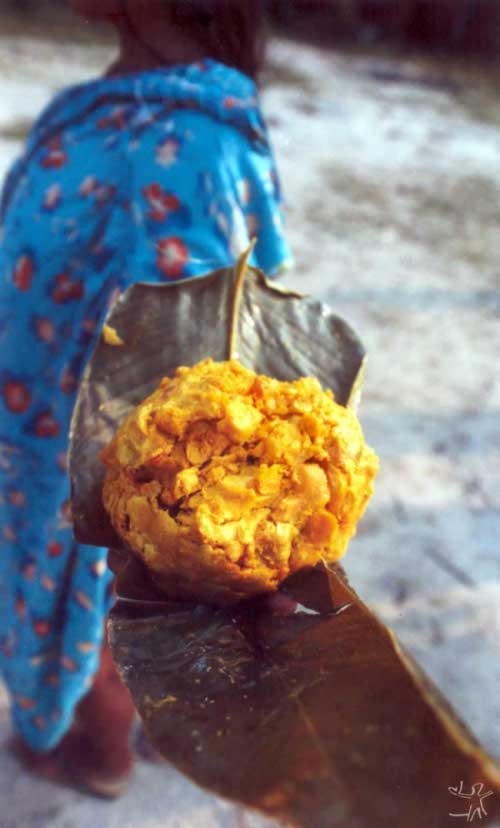
Fish, in turn, is the principal source of animal protein. Various fishing techniques are utilized, each demanding different forms of cooperation. The technique of timbó, which consists of poisoning waters which have been previously dammed up, involves the participation of most of the men of the village. The fish that are killed, whether from the effects of the poison, or from being shot by arrows, are roasted on the fishing grounds. A smaller number of men participate in fishing with nylon nets, which do not require wider cooperation. The various forms of fishing with bows and arrows, small native nets, traps, and hooks, in turn, are done by one or two individuals, or among the members of the nuclear family.
While in the dry season, fish is part of the everyday diet, during the rains, their relative scarcity is compensated by a more varied diet, including corn, papaya, pumpkin, watermelon, among other items. Agriculture still includes the cultivation of other plants both for ceremonial purposes (such as the red dye, urucum, and tobacco), and for the production of various crafted goods (such as gourds and cotton).
The hunting of several birds and small animals, as well as the gathering of forest fruits, also contribute to a varied diet, although they have a secondary role in food production. With regard to hunting, male labor is almost always individual, and has as its principal objectives getting food for the harpy eagle, substituting fish in the diet of people undergoing food restrictions and obtaining feathers for the production of artwork.
In gathering, the work is usually collective and involves the participation of women and children. The principal products are honey, pequi, jenipapo, mangaba, ants, tracajá eggs and firewood. Of these, the nut extracted from the pequi stands out from the others as a ceremonial food distributed on the occasion of inter-village ceremonies. The fruit of the pequi tree becomes abundant at the height of the rains, in January and February, and each village is usually surrounded by extensive plantations of this fruit-tree. The pequi is processed at the time of gathering and is in part stored under water until the time of the Kwarup (in the dry season), when, along with the roasted fish, porridge of manioc and manioc bread, it is the ceremonial food par excelence. The pequi is eaten raw, roasted, or diluted in the manioc porridge.
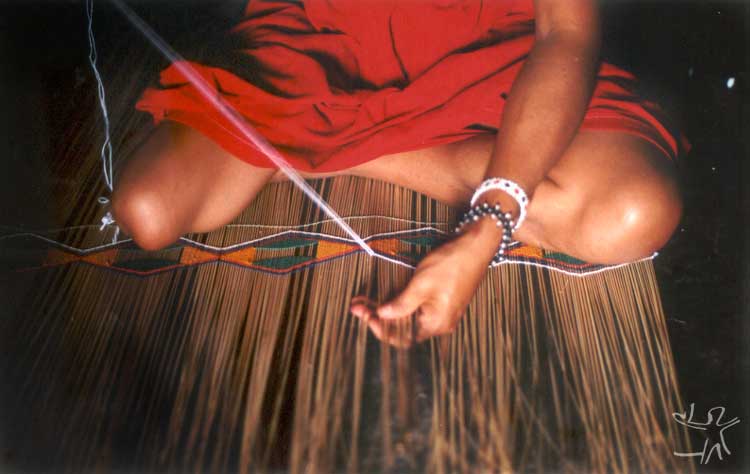
Among the other peoples of the Park, the Kaiabi are outstanding for their sophisticated agriculture in which they cultivate various species of peanuts, sweet manioc, yams, sweet potatoes, mangoes and bananas. Besides producing other types of manioc bread, the Kaiabi also make a large variety of porridges with products from the garden and fruits. The Yudjá, for their part, are known for their production of caxiri (a beverage of fermented manioc), which presently is also consumed by the Kaiabi, Suyá and Trumai. Among these four peoples and the Ikpeng there is a greater consumption of game, including animals such as the wild pig and tapir, which are not consumed by the peoples of the Upper Xingu.
In relation to the production of artwork and articles of clothing, metal objects – on which almost all of male productive activities depends – has not totally substituted the indigenous artwork used by the women in food production. Thus, metal buckets and kettles compete with gourds used in carrying and storing of water, without, however, threatening the position of the ceramic pots, which are obtained through trade with the Wauja.
A large part of the materials employed in the preparation of artwork is of native origin – wood, embira fibre, buriti fibre , cotton etc. But industrialized products are also used, such as glass and porcelain beads, wool and cotton thread, tin, nails, food coloring etc. Of these items, wool thread competes with native cotton thread and in some cases (such as the making of hammocks to sleep) tends to substitute it completely. Other items, such as beads, which are highly valued in the fabrication of collars and belts, have not diminished the importance of native equivalents – snailshells – produced by the Kalapalo and Kuikuro.
Artwork still represents an important commercial economic alternative for the market outside the Xingu. Beyond the family initiatives, the Atix (Indigenous Land association of the Xingu) has taken on the challenge of acting as go-between in these transactions with the Kaiabi, Yudjá and Suyá communities, seeking to define strategies that can amplify the relationship with the market specialized in indigenous artwork in Brazil. The goal of this initiative, which is done in partnership with the ISA, is to conciliate the generation of income with the environmental sustainability of the raw materials utilized in the making of the principal products commercialized, as, for example, the concern for the impact on birds of the making of feather art.
Besides commercializing artwork, recently many villages have developed other projects for economic alternatives that are connected to external markets. Two examples are the apiculture project and the project for production of pequi oil, both in partnership with the ISA. In the case of the Honey Cooperative, Suyá, Trumai, Ikpeng, Yudjá and Kayabi villages participate. Each one produces and gathers the honey, which is sent to a “Honey Center” house, on the Diauarum Post, where it is bottled and sent to Canarana, and then commercialized in Rio de Janeiro and São Paulo. On the average, the production results in two tons of honey per year.
The production of pequi oil, in turn, involves the Ikpeng, Trumai, Kamaiurá, Yawalapiti, Kalapalo, Wauja, Suyá, Matipu, Nafukuá, Kuikuro and Mehinako villages. The type of pequi produced in the Xingu is not found in other regions, being a product which is differentiated both by the agricultural management which it involves and by the social and cosmological significance of the species for these peoples. The idea of joining the efforts of all the villages is to get to a scale of production which is sufficient for sale to a large cosmetics firm, but without industrializing production.
Specialized Trades and the Moitará
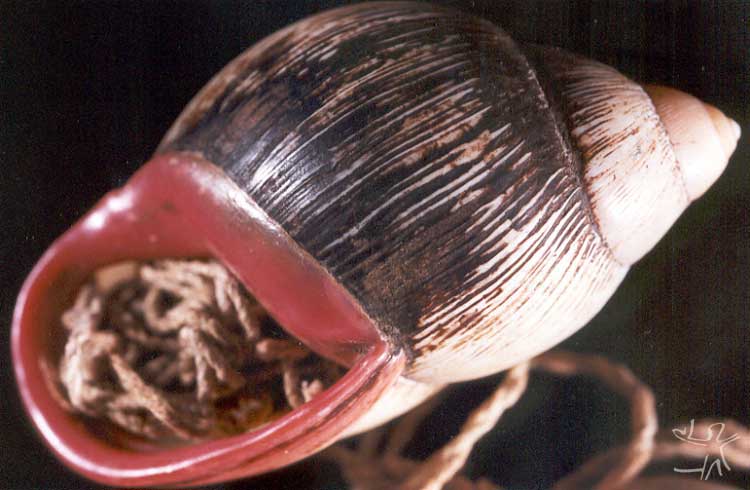
Among the peoples of the upper Xingu, each group is recognized for a certain specialty in production, which allows it to participate in a system of trades with the other groups. Thus the large ceramic pots, with flat bottoms and thick borders turned outwards, are a specialty of the Wauja. The bows made of a hard black wood are produced exclusively by the Kamaiurá. The collars and belts of jaguar claws and snailshells are made by Karib-speaking peoples (Kalapalo, Kuikuro, Matipu and Nahukuá). Salt (potassium chloride, not sodium chloride) is extracted from pond lilies and stored by the Aweti, Mehinako and Trumai. Before the introduction of metal tools, stone axes were furnished by the Trumai, who had the raw material in their territory, but the control of the source was taken over by the Suyá.
In large part, the transactions which involve the trade of these and other products take place during an event that is characteristic of the Upper Xingu called the moitará, which can be of two types: one held among the houses of the same village and the other between different villages. In the first case, it is held only on the initiative of the men or only of the women of a specific house, who show up at another house bringing the objects they wish to trade. Each article is passed from hand to hand among the interested residents of the house visited, until one of them puts the object that s/he wishes to give in trade on the ground. If the trade is accepted by the visitor, s/he picks up the object offered from the ground. Once the transactions are done, the visiting men and women, who can be received with pequi nuts and manioc porridge, leave. And then they wait for a retribution of their visit, when new trades will be made.
The moitará between villages usually takes place in the dry season and involves the joint participation of both sexes. The village that takes the initiative leaves on expedition, led by its chief, to another village, carrying the objects they wish to trade. Although the objects are individual property, the transactions are mediated by the chiefs of the two villages. The exchanges involve ceramics, collars, belts, feather adornments, weapons, canoes, flutes, hammocks for sleeping and fishing nets, baskets, gourds, salt, pepper, foods and animals, especially dogs, besides goods of the White man. Before the trading takes place, the men hold huka-kuka wrestling matches.
Cosmology and rituals

One of the central motifs of cosmology in the Upper Xingu is the difference between the original models of beings, present in the myths, and their later renewals. For example, it is customarily said that the original pequi tree produced much larger fruits, with abundant pulp and small seeds; that the first flutes were aquatic spirits, but the one who discovered them hid them, making wooden imitations, which never could reproduce the potent voice of the original. The first human beings were carved out of wood by the demiurge, who also tried to bring them back to life; as he failed, irreversible death was then commemorated in the ceremony of the Kwarup, in which trunks of the same wood serve as symbol for the dead. The twins Sun and Moon, beyond being the modelers of the Indians of the upper Xingu, are also models for them, since the majority of their mythic adventures consists of the inaugural realization of practices that were later adopted by humans: wrestling, scarification, shamanism.
Thus, myth is not only a collection of founding events which were lost in the dawn of time; myth constantly guides and justifies the present. The geography of the region is dotted with sites where mythic actions unfolded; the ceremonies are explained by the initiative of mythic beings; the world is peopled by immortal beings which go back to the origin of the world; the creators of humanity still live on the Morená. In short, myth exists as a temporal – but, above all, a conceptual - reference.
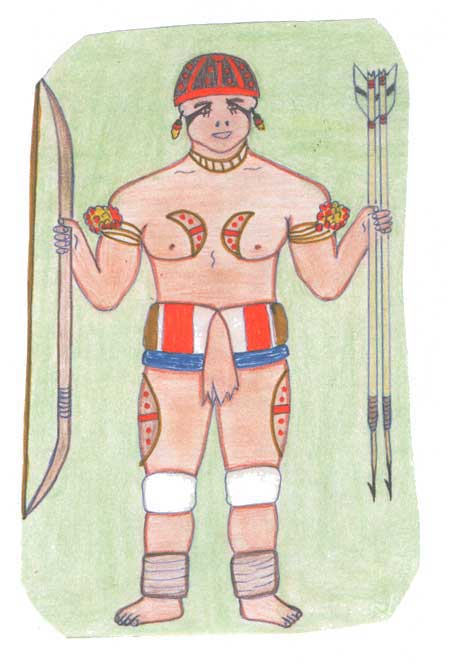
The ceremonies are strictly connected to the mythical universe. On the Upper Xingu, there are two main kinds of rituals. There are the festivals that receive the name of a spirit, generally a spirit which caused a sickness that attacked the host of the festival, and which are restricted to the village. The active participants of this type of ritual – dancers, singers, and musicians – visually or musically represent this spirit. The ceremonies of the other category involve various villages of the Upper Xingu, like the celebration of the deceased aristocrats (better known by their Kamaiurá name, Kwarup) and the duel of darts (Jawari, in Kamaiurá). The latter class of ceremonies was established by the twins Sun and Moon. In the myth, the participating villages are comprised of animals who live in different environments, such as terrestrial animals versus birds, or fish versus terrestrial animals.
In general, what is done in these inter-village rituals is something that is described in a myth, but which is not merely a simple repetition or re-enactment of it. What the ritual celebrates, in fact, is the impossibility of an identical repetition: "now there is only going to be festival", the demiurge said on failing in his attempt to revive the first humans who died, thus inaugurating mortality (the description of this celebration is found in the item "the long ritual of the Kwarup"). In short, the ritual is a reduced iconic model of the superhuman achievements described in myth.
The primordial making of humans, according to upper Xingu mythology, was the work of a demiurge who gave life to wooden logs placed in a seclusion compartment, by blowing tobacco smoke over them. Thus were created the first women, among whom was the mother of the twins, Sun and Moon, archetypes and authors of present-day humanity. In homage to this woman, the first festival of the dead was celebrated, which is the most important festival of the Upper Xingu and which thus consists of a re-enactment of the primordial creation, at the same time it is the privileged moment for public presentation of the young women who have recently come out of puberty seclusion. Thus, it is a ritual that ties together death and life; the girls who come out of seclusion are like the first humans, mothers of men.
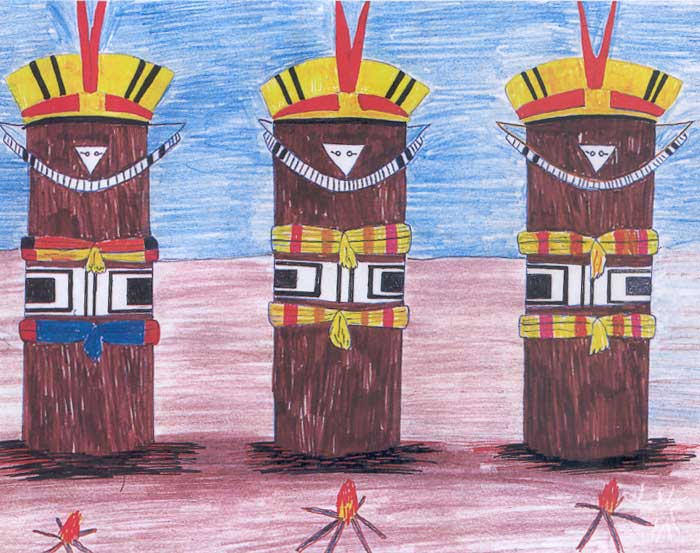
The first humans were thus made in a seclusion chamber. The wooden girls were transformed into people after being closed up in straw compartments similar to those that shelter adolescents in their parents’ house. Echoing this myth of origin, the making of the person in the upper Xingu involves various periods of seclusion, all of which are conceived of as moments for making the body: the couvade (restrictions imposed on married couples with newborn children), puberty, sickness, shamanic initiation, and mourning. This making of the person is also a process of modeling the ideal personality, above all in the case of puberty seclusion, the most important of all seclusions.
In contrast with these periods of making the body, marked by seclusion and liminality, the displaying of the body brings up-to-date the marks of social status (sex, age, ritual role) and characterizes public life, the plaza of the village, the confrontation with other villages of the region and the ceremonial plaza. This contrast seems to strongly mark life in the upper Xingu, which unfolds as the oscillation between these two complementary moments, the dynamics of which result in the construction of the person in these communities. The plaza, plaza speech, the body wrestling, the dance, the display (typically male) of one’s own individuality in the center of the village only exist when articulated with the seclusion compartment, its silence and its secrecy, the lengthy process of making the body and rules for sexual and dietary restraint.
The cosmology and rituals of other peoples of the Park are specific, and thus we suggest visiting their respective pages: Ikpeng, Kaiabi, Suyá and Yudjá. Moreover, the pages dedicated to each ethnic group of the Upper Xingu highlight their singularities which distinguish them from this common repertoire.
[text edited from the chapter by Eduardo Viveiros de Castro, "Outline of Yawalapiti Cosmology", in A Inconstância da Alma Selvagem. São Paulo, Cosac & Naif, 2002]
The long ritual of the Kwarup
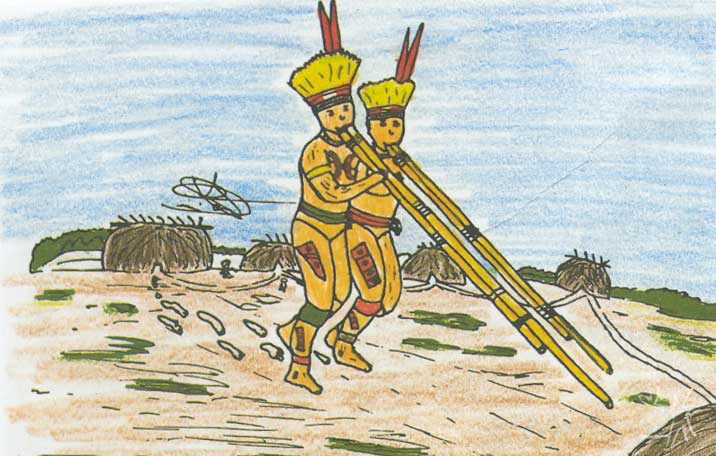
The Kwarup (name of the ritual in the Kamaiurá language, and as it has become known more generally) is considered the great emblem of the Upper Xingu, both by the peoples of the region and by those outside, including by people of the major cities of Brazil, through the media. In fact, it is a funeral ceremony, which involves myths of the creation of humanity, the hierarchical classification into groups, the initiation of Young people and the relations among the villages (in this regard, see the item "cosmology and rituals").
Both the “owner of the village” and the “owners of the houses” have the privilege of a differential form of burial. In the case of the “common” inhabitants, the body is wrapped in a hammock, laid in a grave, later covered by a mat, and finally earth. For the chiefs, there are at least two types of burial. In one of them, the body is tied to a wooden frame similar to a ladder, and placed inside the grave in such a way as to be standing up, facing to the east; in the other type, two graves are dug, three meters distance from each other, and connected by a tunnel. In each grave, a post is placed. The body is placed in a hammock that goes through the tunnel and has its wrists tied to the posts. In both cases, a funeral chamber is made, for the openings of the graves are tamped with mats and ceramic bowls turned upside down, and then covered by earth.
Some time after the burial of a leader, those who prepared the body and placed it in the tomb ask the close kin of the deceased to erect a fence around the burial place. The acceptance of the request by one of the kin marks the beginning of the ritual Kwarup, which covers a long period of time. Its conclusion occurs in the dry season, at the time the tracajá turtle lays its eggs, around August or September. For this final ceremony, the village that is hosting the Kwarup sends an invitation to the other groups of the upper Xingu.
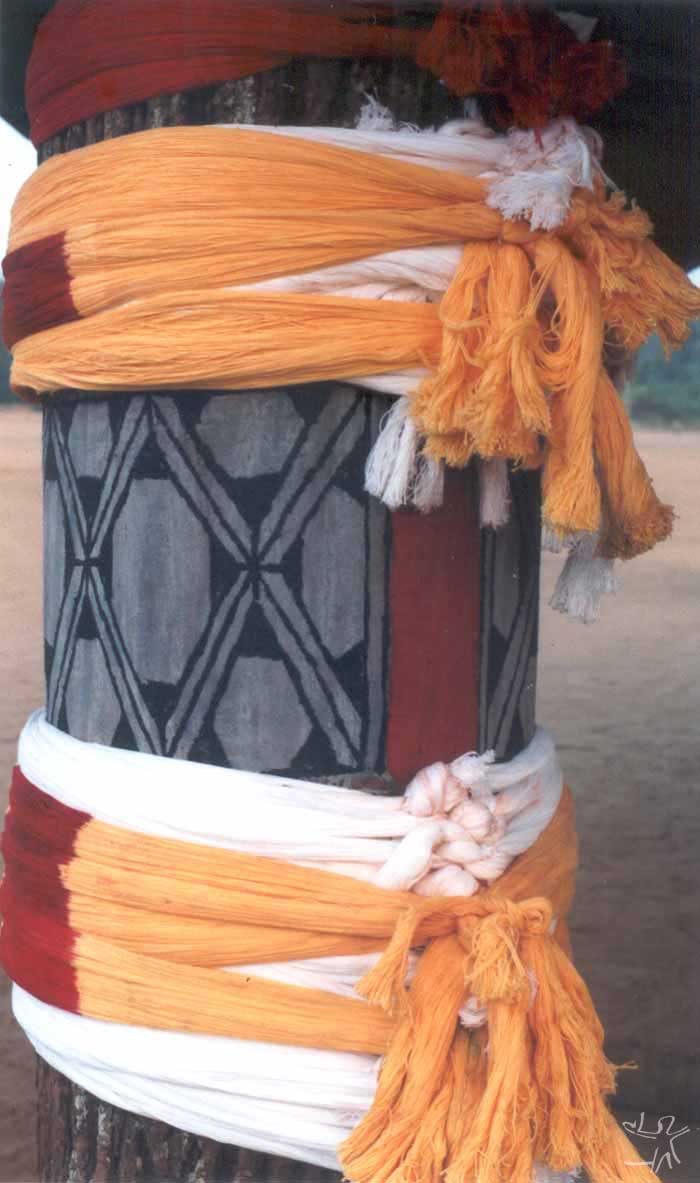
The kinperson who gave permission for building the fence becomes the “owner” of the Kwarup, that is, the one responsible for the organization of the ritual and for providing the food and drink for all those invited, which means he should have available a good supply of manioc. The kin of other deceased “famous men” will also be solicited by their respective gravediggers and, on accepting, they will become secondary “owners” of the same Kwarup. The main “owner” and the secondary owners will in turn invite the kin of deceased “commoners” to get together for the same ritual. But there will only be one fence, which will mark off the tomb of the one for whom the first invitation was made. The gravediggers will yet exercise the important activity of connecting the “owners” with the rest of the village and, at the end of the ritual, also with the guests.
Shortly after putting up the fence, the kin of the deceased are bathed and painted by the gravediggers. At that time, percussion instruments made of a bundle of pequi nutshells used in the initial period of mourning are substituted for rattles, played by two men who shake the rattles in front of the fence of the tomb, an activity which reaches a peak of intensity on the last night of the ritual, when they will play the rattles the whole time in front of the Kwarup trunks.
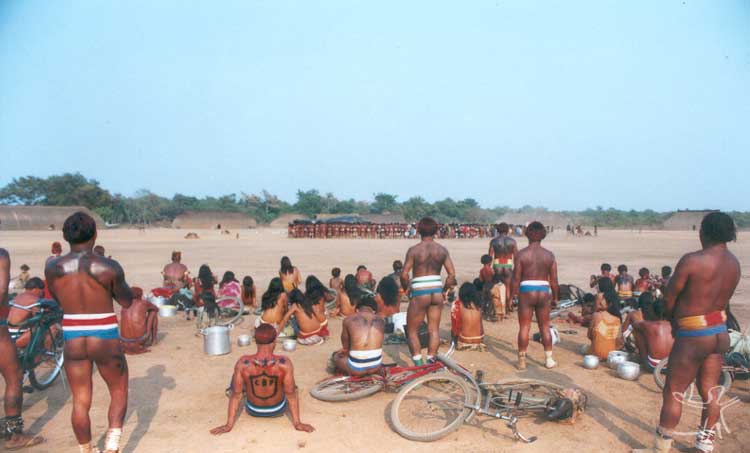
The second important preparatory measure is the gathering of a large quantity of pequi fruits, which ripen in November and December. The gathered fruits are put inside the fence that marks the tomb, until the inner space is filled. They are boiled, their pulp is stored in baskets lined with leaves, which are kept at the bottom of a lake. Their seeds are also kept in small baskets. The fish however have to be caught at most five days before the end of the ritual, given the difficulty of conserving them, even smoked.
Over the months that follow until the end of the ritual, there occur – though not necessarily everyday – two types of dances and the playing of long flutes (uruá, in the Kamaiurá language), always repaid with the offering of food by the “owners” of the Kwarup. The focus of attention in these ritual activities is always the fence over the burial place.
The ideal of inviting to the ritual the largest number of villages possible is limited by the availability of food and by the state of relations among the villages. A messenger, selected from the group of gravediggers, with two others who accompany him, is sent to each village to make the invitation, in a formal style that is well-known to them.
On the Plaza of the village that will host the ritual, each deceased person to receive homage is represented by a section of a trunk of about two meters in length. The trunks are cut from a species that has distinct names depending on the different languages of the Xingu. The Kamayurá call it Kwarup, the same wood that the mythic hero used to make the women that he sent to marry the jaguar. The trunks are placed side by side, upright, stuck in holes 50 centimeters deep. They are painted and decorated with feather adornments and male belts. The only difference between the trunks that represent the men and those that represent the women is that the first have unrolled cotton bands tied around them (see photo). Also the deceased common men have the right to be represented by trunks, but of less thickness and with simpler ornamentation. The spirits of the deceased who receive homage stay together with the trunks on the last night of the ritual and their participation is reduced to that time.

The Kwarup trunks then become the focus of the ritual development, while the fence around the burial place is removed and transformed into firewood for the hearths of the camping places of the invited villages, the representatives of which arrive on the day that precedes the last night of the ritual. On their arrival, the messengers who made the invitation lead the “captains” of the guests of each village by the hand, to whom food and a place to sit is offered on the plaza. After being served, ththey go back to their camping-place.
At nightfall, they light fires in front of each Kwarup trunk. While the residents of the host village take turns, keeping wake over the trunks and weeping for the deceased who receive homage, the visitors of each camp enters in its turn into the village, bringing logs of pindaíba to rekindle the fires, in a tense and stirring scene.
In the morning, the guests and hosts prepare themselves for the huka-huka, a wrestling match which in Kamaiurá terminology recalls the cries of the wrestlers who, on facing each other, imitate the grunting of the jaguar. The hosts confront one invited village at a time, beginning with individual matches of recognized champions. These are followed by simultaneous matches of various pairs of rivals, up to the matches of the youngest wrestlers. The wrestlers face each other stamping their right feet on the ground, making clockwise turns around each other, with their left arms extended and their right arms held back, while they shout back and forth: hu! ha! hu! ha! Until their right hands hit and they grab the neck of their adversary with the left. The match, which can last a few seconds, ends when one of the adversaries is thrown to the ground, which does not have to happen literally, it being enough that the back part of one of his knees be snatched by the hand of his adversary, which is considered a sufficient condition for causing him to fall. The villages invited do not wrestle amongst themselves. The adornments of the Kwarup trunks can be given to the winning wrestlers and also to the two rattle-players.
After the match, one of the girls who was in puberty seclusion, who by now is very light in color due to her not having been exposed to the sun for months, and with her hair very long, her bangs down to her chin, since they have not been cut during seclusion, offers pequi seeds to the leaders of one of the invited villages, while the “commoners” of the same village take off her garters. This is repeated with the representatives of each one of the invited villages. The act has a very clear sexual connotation, for both in the myth and in daily life the woman has sexual relations without her garters. Besides that, the Xingu people confess that the smell of the pequi was transferred by a mythical hero from the sexual parts of the woman to this fruit.
Food is then offered to the visitors. Duos of visiting uruá (in kamaiurá) flute-players and also hosts play these instruments, accompanied by girls who have come out of seclusion, and they dance throughout the village, going in and out of the houses. The ritual ends with the farewell of the guests.
The ritual of the Jawari
Another ritual which involves invitations to other villages is that of the Jawari, held around the month of July. This ritual involves a series of disputes, each of them between two individuals of different ethnic groups, placed about six meters from each other. Each one by turns shoots darts at his opponent, seeking to strike him from the waist on down. The players protect themselves by hiding, dodging, or jumping behind a bundle of sticks, which cannot move from the ground. The darts have their tips blunted with balls of wax and their shafts are stuck in a tucum fruit (called Jawari in the Kamaiurá language, as the ritual became better known), with holes, which makes them hiss, when thrown. The darts are thrown with the help of a propeller, an instrument which was widely diffused in the past, but which today, in Brazil, only exists on the Upper Xingu and the use of which is limited to this sport.
For the holding of this ritual, three emissaries, one main emissary and two assistants, are sent to the village which is to be invited requesting that the villagers appear on the appointed day, at which time they are received by the same emissaries, who bring them cauim [fermented beverage] and manioc bread. The guests pitch camp outside the village. On the following day, they enter to engage in the contest.
On the days preceding the games, the adversaries must undergo assiduous training, using as a target a doll made of leaves tied with embira. Sexual relations and the consumption of fish must also be avoided.
Once the contest has ended, food is offered to the visitors. Near a ceramic bowl, several darts and propellers from each group are broken and then burned. Having finished the meal, the guests return to their village.
The female ritual of Yamurikumã
The house of the flutes, in the center of the village, hides the instruments that the women can hear, but not see. The flutes are hung on the centre beam of the roof and can be played at any time, by a group of three men inside the house. At night, when the women have retired, the men can go out onto the patio with the flutes. Also they may be taken out into open air on the occasion of collective male tasks, which are recompensed by food prepared by the one for whom the tasks are done. On these occasions, the women have to shut themselves up in their houses.
But the women invert this situation in the ritual of Yamurikumã (in Kamaiurá terminology, which is the most widespread in the region), held in the dry season, in which they perform with weapons, typically male movements and feather ornaments and ankle rattles, which are normally used by the men; they even wrestle the huka-huka.
Receiving guests from other villages, who remain camped in the vicinity (as in the Kwarup), the participants chant songs that refer to male sexuality. There are various types of songs, some which mention the events which originated this ceremony, many which reproduce the structure of the male performances with the flutes, and other which explicitly simulate the aggressive sexuality of the men before certain women. The men, who can be attacked, withdraw.
Shamanism

The peoples of the Park recognize the interference of a multiplicity of spiritual beings in the lives of humans. There is a profusion of spirits, from the spirits of the plants, fish, furry animals, stars, objects, to the more important spirits, associated with the flutes that are prohibited to the women and with the female ritual of Yamuricumã. They are the spirits that cause most sicknesses, by appearing to humans in the forest, and it is these that help the shamans to cure them. The spirits are invisible, and only appear to the sick and to the shamans in trance.
The spirit beings are usually in all parts, except inside the village, where they appear only in extraordinary situations of sickness, shamanism and ritual. Their relation with humans occurs predominantly on an individual basis, in the basic form of sickness. They consider that all sicknesses are the result of a contact with the supernatural world, whether through the action of a witch or through the accidental encounter with a spirit.

In order to effect a cure, the shaman contacts the spirit that caused the sickness by means of a trance stimulated by the use of large cigars of tobacco. Generally, the cure is done by blowing smoke over the sick person, or by removing the witchcraft, or even by identifying the spirit that was induced by the witch to enter into the sick person’s body.
The shaman thus exercises control over the relations between the village and the supernatural world: he regulates the relations between men and the spirits that inhabit the waters and forest; through his diagnosis, the spirits that cause sickness are socialized by the ritual. The witch, in turn, represents the paradigm of the marginal being: he is the backdoor man, who invades the houses, who puts witchcraft on the gardens, who is transformed into an animal in the forest. In most cases, the principal witchcraft suspects are inhabitants of other villages or come from other ethnic groups.
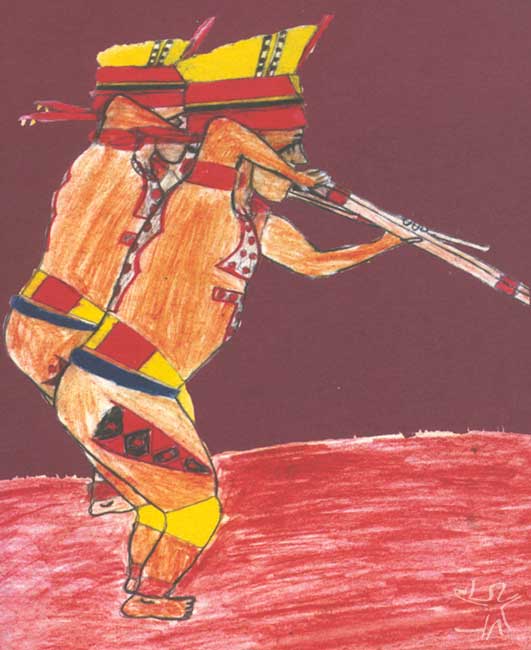
In the Upper Xingu, the individual who has been cured then comes to be in debt to the spirit who caused /cured the sickness. He must then sponsor a ceremony in which he pays homage to the spirit through songs, dances, and body adornments. This ceremony is the moment when the domestic group distributes food to everyone in the village. The spirit is incarnated-represented by the community, and both are fed by the family of the sick person.
Thus, sickness cannot be understood as an absolute evil, or it is not only that. A large part of the ritual system of the Upper Xingu is driven by ideas connected to sickness, and the circuit of reciprocity activated by these ceremonies has a crucial role in the social dynamics of the villages, mediating the relations between individual and society (Viveiros de Castro 2002:81).
Indigenous associations

The initiative of forming associations means, above all, the Indians’ attempt to gain autonomy in the administration of community interests which connect directly with the public and private institutional world of the national society. In the last several years, five associations have been created in the Xingu Park and, apparently, this number is increasing. Out of the existing associations, three are connected to local interests of specific villages: Mavutsinim, of the Kamaiurá; Jacuí, of the Kalapalo, as well as the association of the Wauja. In 1994, Atix (the Indigenous Land Association of the Xingu) was created, which includes 14 ethnic groups of the Park, which serves interlocal interests. On its agenda, there are projects for cultural revitalization, protection and fiscalization of the territory, besides educational and health programs and economic alternatives. The Atix has the institutional support of the Rainforest Foundation of Norway with the ISA as consultants.
The associations, in general, are equipped with an administrative structure which does not exist in the traditional forms of political organization of the indigenous societies. The assimilation and administration of an associational model with bureaucratic trappings enters into conflict with traditional politics, as it presupposes command of the Portuguese language, mathematical operations, legislation and inter-institutional relations that govern the universe of private law entities. Consequently, an indigenous association doesn’t always succeed in reconciling the traditional politics of the village, which is generally controlled by the elders, with the political administration of matters that connect with the national society, which in practice is being monopolized by younger individuals. It is these younger individuals who dominate the new knowledge which is indispensable to this interface.
The sustainability of an association with the broad profile of the Atix, which manages a diversified set of projects, requires partnerships that, at least in part, support its operation. As the Atix incorporates people of different ethnic groups among its personnel, its headquarters is not localized in a single village but on the Diauarum Indigenous Post, with sub-headquarters in the city of Canarana (MT). This situation demands, undoubtedly, exclusive dedication of the majority of its members, who, besides other things, have to take up residence near the headquarters of the Association. Hence the difficulty of guaranteeing the operation of an association of this type without institutional support.
Another important aspect for the maintenance of the associations is the question of the training of its members in order to adequately manage administrative and financial aspects, as well as relations with the outside. Towards this end, the Atix, with the assessment of the ISA, has sought to put into practice an intense and continuous effort at training its staff, Since 1995 it has been sponsoring and participating in various courses, such as mechanics (in partnership with the Senai-PA), computer training for the directors, self-schooling and the preparation, administration and accounting of projects.
In the context of the Park, where the administration of the Funai, since 1985, is in control of the Indians, the growth of the Atix means, in a way, a new administrative alternative that is revealing the contradictions of a process in which the Indians were raised up from the condition of conduits of the actions of the state, without having been given the conditions necessary for assuming this role with autonomy.
[André Villas Bôas]
Health and Education
At the present time, the Park has 68 teachers from 14 ethnic groups, who teach in 36 schools located in the villages and indigenous posts, serving 1,258 students. The teachers composed the Pedagogical Political Project for their schools, from the 1st to 4th stages ( equivalent to the first four grades of basic education), with a specific and culturally differentiated program, developed with the consultancy of the education staff of the ISA.
Most of the schools are connected to the Secretary of Education of the State of Mato Grosso, although there are seven schools connected to municipalities around the Park. Since 1994 indigenous alphabets have been developed by the teachers, with the help of linguists, for writing all the languages. The teachers produce their own didactic books in the indigenous languages and in Portuguese.
In relation to health, discussion of the re-organization of services in this area began in 1990, organized by the Unifesp/Escola Paulista de Medicina and initially involving the Indigenous Health Agents and several local leaders. The maintenance of a regular training program for Indigenous Health Agents, the work developed by the health staff and the meetings of the Counsel of Leaders of the ATIX have made it possible to create contexts which have facilitated the participation of the communities in the discussion of their health problems. At the same time, they have made a greater inter-institutional articulation possible with the involvement of the National Health Foundation (Funasa), Funai, Secretary of Health of the State of Mato Grosso (SES/MT) and municipal secretaries of health (SMS) of several municipalities around the Xingu Park, composing a more favorable picture with regard to the organization of health assistance on the regional level. As a result, the process of establishing the Indigenous Special Sanitary District of the Xingu (DSEI/ Xingu) is characterized by the change of sanitary practices, which are now done according to a new paradigm centered on health care.
The DSEI/Xingu officially began its activities on August 12, 1999, through an agreement established between the Funasa and the Unifesp. By the terms of the agreement, the Unifesp is responsible for taking care of basic assistance actions from the villages to the referral services of the regional Health Unit Services (SUS). It is up to the National Health Foundation to repass the financial resources, monitor and accompany actions related to the control of endemic diseases such as malaria and dengue.
The District seeks to implement an integral approach to health, taking into consideration all of the determining factors in the health-sickness process: sociocultural, political, environmental, and biological. The organization of health services has as its basic principles, equity, accessibility, hierarchy and decentralization. The territory for health assistance was divided into three areas of coverage, each corresponding to a base-pole: Leonardo, Pavuru and Diauarum. A series of localities and corresponding population are served by each base-pole. Each base-pole has a multi-professional health team, comprised of doctors, nurses, nursing assistants and indigenous health agents.
First aid is done in the territorial space of the villages, on a continuous basis. It consists of basic health assistance actions, promoting health and sanitation which is the responsibility of the health agents and indigenous teachers, with the support and participation of the staff of the corresponding area. When it is not possible to resolve the problem in the village, the sick are sent to the Basic Health Units (UBS) located on the base-poles(headquarters of the areas covered).
[With the collaboration of healthworkers from the Unifesp Douglas Rodrigues and Sofia Mendonça]
Notes on the sources
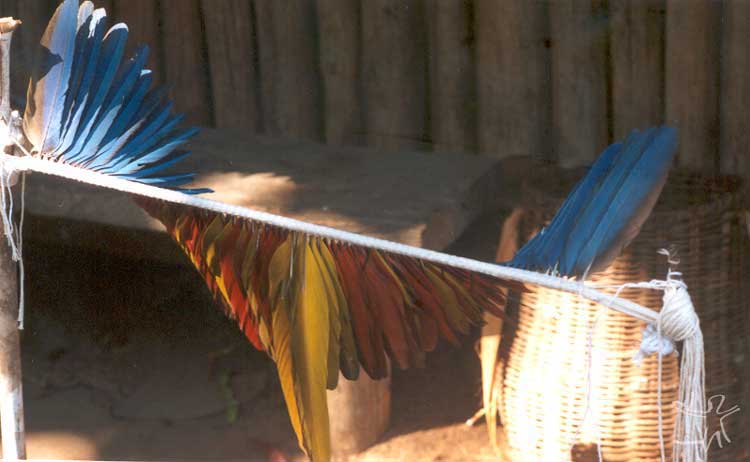
Actually, there are published Works on the different peoples of the Xingu, which can be found in the bibliographies of the entries for each of these peoples. Here reference will be made only to those works that deal with the region of the Upper Xingu as a whole.
Among the Works by the first ethnologists who were on the Upper Xingu, there is a Portuguese translation of the two books by Karl von den Steinen (the one referring to his second Voyage, Entre os Aborígenes do Brasil Central, [Among the aborigines of Central Brazil] is the one that contains the most ethnographic information) and the book by Max Schmidt, Estudos de Etnologia Brasileira.[Studies of Brazilian Ethnology]
Among the Works from the mid-XXth Century, there are the articles by Eduardo Galvão and the volume by Kalervo Oberg (whose expedition included his students of the School of Sociology and Politics of São Paulo, such as Fernando Altenfelder da Silva).
The cathedra thesis by Egon Schaden, Aculturação Indígena, [Indigenous Acculturation] defended at the University of São Paulo in 1965, has an interesting chapter based on the bibliography available at that time, which discusses the relations between the Xingu Indians from the end of the XIXth Century to the mid-XXth Century. The book by Pedro Agostinho, Kwarup, published several years later, although focused on the holding of this important ritual among the Kamayurá, offers a very vivid account of their attitudes in relation to the guests, from other ethnic groups. On the Kwarup, Heinz Forthmann produced a documentary film which illustrates very well the description provided in Agostinho’s book.
The Diário do Xingu, [Diary of the Xingu] by Berta Ribeiro, provides a description of the Park, at the same time it relates the journey of this ethnologist from the south to the north of the Park. An equivalent visual account is offered by the video produced by Washington Novaes, shown years ago in a television series.
Orlando Villas-Bôas dedicated himself to describing his experience as backwoodsman and indigenist in a series of articles and 12 books, among which is A Marcha para o Oeste – A Epópeia da Expedição Roncador -Xingu.[The March to the West – Epopeia of the Roncador-Xingu Expedition]. In 2002, O Xingu dos Villas Bôas, [The Xingu of the Villas-Bôas] was published, with more than 300 photos, testimonies and informative texts about the Villas-Bôas brothers and the Indigenous Park of the Xingu.
Recently, the volume Os Povos do Alto Xingu: História e Cultura (2001), [The Peoples of the Upper Xingu: History and Culture] was organized by Bruna Franchetto and Michael Heckenberger which brings together articles by the editors and other researchers who have done research in the area, some for many years, studying the peoples of the upper Xingu. The overall goal of the volume is to show that the Upper Xingu has a long past that can be investigated and interpreted, both from the perspective of researchers and from the different points of view of the distinct indigenous peoples.
Sources of information
- AGOSTINHO DA SILVA, Pedro. Aldeias indígenas do alto Xingu : uma perspectiva arqueológica. In: LIVRO em homenagem a Orlando Ribeiro. v. 2. Lisboa : Centro de Estudos Geográficas, 1988. p. 679-90.
- --------. Estudo preliminar sobre o mito de origens Xinguano: comentário a uma versão Aweti. Universitas, Salvador, n. 6/7, p. 457-519, 1970.
- --------. Geografia e cultura no Alto Xingu. Geografia: Revista da Sociedade de Geografia de Lisboa, Lisboa, v. 3, n.12, 1967.
- --------. Informe sobre a situação territorial e demográfica no alto Xingu. In: GRÜNBERG, Georg (Coord.). La situación del indígena en América del Sur : aportes ao estudio de la fricción inter-etnica en los índios no-andinos. Montevidéu : Tierra Nuev, 1972. p. 355-79.
- --------. Kwarup : mito e ritual no Alto Xingu. São Paulo : EPU ; Edusp, 1974.
- --------. Mito e outras narrativas Kamayura. Salvador : Editora da UFBA, 1974.
- --------. Testemunhos da ocupação pré-xinguana na bacia dos formadores do Xingu. In: COELHO, Vera Penteado (Org.). Karl von den Steinen : Um século de antropologia no Xingu. São Paulo : Edusp, 1993. p. 233-87.
- BARCELOS NETO, Aristóteles. A arte dos sonhos : uma iconografia ameríndia. Lisboa : Museu nacional de Etnologia ; Assírio & Alvim, 2002.
- --------. De etnografias e coleções museológicas : hipóteses sobre o grafismo xinguano. Florianópolis : UFSC, 1997. (Antropologia em Primeira Mão, 22)
- BARUZZI, Roberto G.; IUNES, M. Levantamento das condições de saúde das tribos indígenas do Alto Xingu. São Paulo : EPM ; Brasília : MEC, 1970.
- --------.; MARCOPITO, L. F.; IUNES, M. Programa médico preventivo da Escola Paulista de Medicina no Parque Nacional do Xingu. Rev. de Antropologia, São Paulo : USP, n.21, p.155-70, 1978.
- --------., RODRIGUES, Douglas A.; WÜRKER, Estela et al. Health care program proposal : Escola Paulista de Medicina's health activities in the Parque Indígena do Xingu. São Paulo : EPM, 1990.
- BASSO, Ellen B. (Ed.). The carib speaking indians : culture, society and language. Tucson : Univers. of Arizona, 1977. (Anthropological Papers of the University of Arizona, 28).
- --------. A husband for his daughter, a wife for her son : strategies for selecting a set of in-laws among the Kalapalo. In: KENSINGER, Kenneth M. (Ed.). Marriage practices in lowland South America. Urbana : University of Illinois Press, 1984. p. 33-44.
- --------. In favour of deceit : a study of tricsters in an Amazonian society. Tucson : Univers. of Arizona Press, 1987.
- --------. Kalapalo biography : psychology and language in a South american oral history. American Anthropologist, Lancaster : American Anthropological Association, n. 91, p.551-69, 1989.
- --------. The Kalapalo indians of Central Brasil. New York : Holt, Rinehart and Winston, 1973.
- --------. The last cannibal : a South American oral history. Austin : The University of Texas Press, 1995.
- --------. A musical view of the universe : Kalapalo myth and ritual performances. Filadélfia : Univers. of Pennsylvania Press, 1985.
- --------. The use of portuguese relationship terms in Kalapalo (Xingu Carib) enconunters : changes in a central Brazilian communication network. Language and Society, n.2, 1973.
- BASTOS, Rafael José de Menezes. Cargo anti-cult no Alto-Xingu : consciência política e legítima defesa étnica. Boletim de Ciências Sociais, Florianópolis : UFSC, n. 38, 36 p., 1985.
- --------. Esboço de uma teoria da música : para além de uma antropologia sem música e de uma musicologia sem homem. Anuário Antropológico, Rio de Janeiro : Tempo Brasileiro, n.93, p. 9-73, 1995.
- --------. Exegeses Yawalapití e Kamayurá da criação do Parque Indígena do Xingu e a invenção da saga dos irmãos Villas-Boas. Rev. de Antropologia, São Paulo : USP, n.30/32, p. 391-426, 1992.
- --------. A festa da jaguatirica : uma partitura crítico-interpretiva. São Paulo : USP/Depto Antropologia, 1989. (Tese de Doutorado).
- --------. Indagação sobre os Kamayurá, o Alto-Xingu e outros nomes e coisas : uma etnologia da sociedade Xinguara. Anuário Antropológico, Rio de Janeiro : Tempo Brasileiro, n.94, p. 227-29, 1995.
- --------. Música nas terras baixas da América do Sul : ensaio a partir da escuta de um disco de música Xikrín. Anuário Antropológico, Rio de Janeiro : Tempo Brasileiro, n.95, p. 251-63, 1996.
- --------. A musicológica Kamayurá : para uma antropologia da comunicação no Alto-Xingu. Brasília : UnB, 1976. (Dissertação de Mestrado).
- --------. A musicológica Kamayurá : para uma antropologia da comunicação no Alto Xingu. Brasília : Funai, 1978.
- --------. O "Payemeramaraaka" Kamayurá : uma contribuição à etnografia do xamanismo do Alto Xingu. Rev. de Antropologia, São Paulo : USP, n. 27/28, p.127-38, 1984/1985.
- --------. A saga do Yawari : mito, música e história no Alto Xingu. In: CASTRO, Eduardo Viveiros de; CUNHA, Manuela Carneiro da (Orgs.). Amazônia : etnologia e história indígena. São Paulo : USP, 1993. p.117-46.
- --------. Sistemas políticos, de comunicação e articulação social no Alto-Xingu. Anuário Antropológico, Fortaleza : UFCE ; Rio de Janeiro : Tempo Brasileiro, n. 81, p. 43-58, 1983.
- --------. Sobre a noção de tutela dos povos e indivíduos indígenas pela União. In: SANTOS, Silvio Coelho dos (Org.). O índio perante o direito : ensaios. Florianópolis : UFSC, 1982. p.51-60.
- --------; BASTOS, Hermenegildo José de Menezes. A festa da jaguatirica : primeiro e sétimo canto - Introdução, transcrições, traduções e comentários. Florianópolis : UFSC/PPGAS, 1995. (Antropologia em Primeira Mão, 2)
- BECQUELIN, Pierre. Arqueologia Xinguana. In: COELHO, Vera Penteado (Org.). Karl von den Steinen : Um século de antropologia no Xingu. São Paulo : Edusp, 1993. p. 223-32.
- --------. Pesquisas arqueológicas no Parque Nacional do Xingu, Mato Grosso. Belém : MPEG, 1980.
- BROWN, M. Facing the state, facing the nation : Amazonia’s native leaders and the new politics of identity. L’Homme, Paris : Ecole des Hautes Etudes en Sciences Soc., n. 126/128, p.307-26, 1993.
- BUTT-COLSON, A. The shaman's legal role. Rev. do Museu Paulista, São Paulo : Museu Paulista, n. 16, p.151-86, 1965/66.
- CARNEIRO, R. L. The cultivation of manioc among the Kuikuru indians of the Upper Xingu. In: HAMES, Raymond B.; VICKERS, William T. (Eds.). Adaptive responses of native amazonians. New York : Academic Press, 1983. p. 65-lll.
- --------. The ecological basis of Amazonian chiefdoms. New York : American Museum of Natural History, 1986. (Manuscript on File)
- --------. Extra-marital sex freedom among the Kuikuro indians of Mato Grosso. Rev. do Museu Paulista, São Paulo : Museu Paulista, n.10, p.135-42, 1956/1958.
- --------. Factors favoring the development of political leadership in Amazonia. In: KRACKE, W. H. (Ed.). Leadership in Lowland South America. Bennington, 1993. p. 4-8. (South American Indian Studies, l).
- --------. Further reflections on resource concentration and its role in the rise of the state. British Archaeological Reports: International Series, n. 349, p 245-60, 1987.
- --------. The history of ecological interpretations of Amazonia : does Roosevelt have It right? In: SPONSEL, L. E. (Ed.). Indigenous peoples and the future of Amazonia : an ecological anthropology of an endangered world. Tucson : University of Arizona Press, 1995. p. 45-65.
- --------. The knowledge and use of rain forest trees by the Kuikuru, indians of Central Brazil. In: FORD, R. I. (Ed.). The nature and status of ethnobotany. Ann Arbor : Museum of Anthropology, Univers. of Michigan, 1978. p. 201-16. (Anthropological Papers, 67).
- --------. Kuikuru. In: WILBERT, J. Encyclopedia of World Cultures. v. 7. Boston : G. K. Hall & Co., 1994. p. 206-209.
- CARNEIRO, Robert L. A origem do lago Tahununu, um mito Kuikuro. In: FRANCHETTO, Bruna; HECKENBERGER, Michael J. (Orgs.). Os povos do Alto Xingu : história e cultura. Rio de Janeiro : UFRJ, 2001. p. 287-92.
- --------. Quarup : A festa dos mortos no Alto Xingu. In: COELHO, Vera Penteado (Org.). Karl von den Steinen : Um século de antropologia no Xingu. São Paulo : Edusp, 1993. p. 405-29.
- --------. Recent observations of shamanism and witchcraft among the Kuikuru indians of Central Brazil. Annals of the New York Academy of Science, n.293, p.215-28, 1977.
- --------. Slash and burn agriculture: a closer look at its implications for settlements patterns. In: WALLACE, A. F. C. (Org.). Men and cultures : selected papers of 5th International Congress of Anthropological and Ethnological Sciences, 1960.
- --------. Slash-and-burn cultivation among the Kuikuru and Its implications for cultural development in the Amazon basin. In: LYON, P. Native South americans : ethnology of the least known continent. Illinois : Waveland Press, Prospect Heights, 1985. p.73-91.
- --------. Subsistence and social structure : an ecological study of the Kuikuru indians. Ann Arbor : University of Michigan, 1957. (Unpublished Ph.D. Dissertation).
- --------. Village splitting as a function of population size. In: DONALD, L. (Ed.). Themes in ethnology and culture history, essays in honor of David F. Aberle. Meerut, India : Archana Publications, Folklore Institute, 1987. p. 94-124.
- CARVALHO, J. C. M. Relações entre os índios do Xingu e a fauna regional. Rio de Janeiro : Museu Nacional, 1951. (Publicações Avulsas).
- --------; LIMA, P. E.; GALVÃO, Eduardo. Observações zoológicas e antropológicas na região dos formadores do Xingu. Rio de Janeiro : Museu Nacional, 1949. (Publicações Avulsas, 5).
- CARVALHO, S. O grande bandeirante Antonio Pires de Campos (1716-1756). Rev. do Inst. Hist. de Mato Grosso, Cuiabá, n. 53/56, p.92-6, 1946.
- COELHO, Vera Penteado (Org.). Karl von den Steinen : Um século de antropologia no Xingu. São Paulo : Edusp, 1993. 632 p.
- CUNHA, A. C. Entre os índios do Xingu. São Paulo, 1953. (Exposição do Livro).
- DOLE, Gertrude E. Homogeneidade e diversidade no alto Xingu vistas a partir dos Cuicuros. In: COELHO, Vera Penteado (Org.). Karl von den Steinen : Um século de antropologia no Xingu. São Paulo : Edusp, 1993. p. 375-403.
- --------. Ownership and exchanges among the Kuikuru Indians of Mato Grosso. Revista do Museu Paulista, São Paulo, v. 10, p.125-33, 1956/1958.
- --------. A preliminary consideration of the prehistory of the Upper Xingu basin. Revista do Museu Paulista, São Paulo, n.s., v.13, p.399-423, 1961/1962.
- --------. Shamanism and political control among the Kuikúru. In: GROSS, D.(ed.). Peoples and cultures of native South America. New York : Doubleday/The Natural History Press, 1973[1964]. p. 294-307.
- --------. Some aspects of structure in Kuikuru society. Antropologica, Ann Arbor : University of Michigan/ Museum of Anthropology, v. 59/62, p.309-29, 1984.
- --------. The structure of Kuikuru marriage. In: KENSINGER, K.M. (Ed.). Marriage practices in lowland South America. Chicago : University of Illinois Press, 1984. p. 45-62.
- DREYFUS, Simone. Alliances inter-tribales et systèmes de parenté du Haut Xingu (Brésil central). In: PUILLON, J.; MARANDA, P. (orgs). Échanges et communications : mélanges offerts à Claude Lévi-Strauss à l’occasion de son 60ème anniversaire. Paris : Mouton, 1970. p. 258-71.
- DURBIN, M. A survey of the Carib language family. In: BASSO, Ellen B. (Ed.). The carib speaking indians : culture, society and language. Tucson : Univers. of Arizona Press, 1977. p. 23-38. (Anthropological Papers of the University of Arizona, 28).
- EHRENREICH, P. Contribuições para a etnologia do Brasil (traduzido por Egon Schaden). Revista do Museu Paulista, São Paulo, v.37, p.135, 1948.
. A segunda expedição alemã ao rio Xingu. Revista do Museu Paulista, São Paulo, v.16, p. 247-75, 1929.
- EMMERICH, C. A língua de contato no Alto Xingu : origem, forma e função. Rio de Janeiro : UFRJ, 1984. (Tese de Doutorado).
- FERREIRA, M. L. Escrita e oralidade no Parque Indígena do Xingu : inserção na vida social e a percepção dos índios. Revista de Antropologia, São Paulo : USP, v. 35, p. 91-128, 1992.
- FERREIRA, Manoel Rodrigues. Terras e índios do Alto Xingu. São Paulo : Melhoramento, 1950.
- FRANCHETTO, Bruna. O aparecimento dos caraíba : para uma história Kuikuro e Alto-Xinguana. In: CUNHA, Manuela Carneiro da (Org.). História dos Índios no Brasil. São Paulo : Companhia das Letras ; Fapesp ; Secretaria Municipal de Cultura, 1992. p. 339-56.
- --------. A celebração da história nos discursos cerimoniais kuikúro (Alto Xingu). VIVEIROS DE CASTRO, Eduardo; CUNHA, Manuela Carneiro da (Orgs.). Amazônia : etnologia e história indígena. São Paulo : NHII/USP ; Fapesp, 1993. p.95-116.
- --------. Escolas e integração : o caso do Parque Indígena do Xingu. Em Aberto, Brasília : MEC/Inep, v.3, abr./jun. 1984.
- --------. Laudo antropológico : a ocupação indígena da região dos formadores e do alto curso do rio Xingu (Parque Indígena do Xingu). Rio de Janeiro : Museu Nacional, 1987. 159 p.
- --------. Rencontres rituelles dans le Haut Xingu : la parole du chef. In: BECQUELIN-MONOD, Aurore; ERIKSON, Philippe (Orgs.). Les rituels du dialogue : promenades ethnolinguistiques en terres amérindiennes. Nanterre : Société d’Ethnologie, 2000. p.481-510.
- --------; HECKENBERGER, Michael. Os povos do Alto Xingu : história e cultura. Rio de Janeiro : UFRJ, 2001. 492 p.
- FREIRE, C.A. da Rocha. Saudades do Brasil ou as lutas pela criação do Parque Indígena do Xingu. Rio de Janeiro : UFRJ/Museu Nacional, 1987.
- FREITAS, Francisco Alves. Fundação Brasil Central. Brasília : Sudeco, s.d.
- GALVÃO, Eduardo. Áreas culturais do Brasil : 1900 - 1959. Boletim do MPEG: Série Antropologia, Belém : MPEG,n.s., n.8, 1960.
- GALVÃO, Eduardo. Cultura e sistema de parentesco das tribos do alto rio Xingu. In: --------. Encontro de sociedades : índios e brancos no Brasil. Rio de Janeiro : Paz e Terra, 1979. p.73-119. Originalmente publicado no Boletim do Museu Nacional: Antropologia, Rio de Janeiro : Museu Nacional, Nova Série, n.14, 1953.
- --------. Diários de campo entre os Tenetehara, Kaioá e índios do Xingù. Rio de Janeiro : UFRJ ; Museu do Índio, 1996.
- --------. O uso do propulsor entre as tribos do alto Xingu. In: --------. Encontro de sociedades : índios e brancos no Brasil. Rio de Janeiro : Paz e Terra, 1979. p.39-56. Originalmente publicado na Revista do Museu Paulista, São Paulo : USP, Nova Série, n. 4, p.353-68, 1950.
- GALVÃO, Eduardo; SIMÕES, Mário F. Mudança e sobrevivência no alto Xingu, Brasil Central. In: SCHADEN, Egon (Org.). Homem, cultura e sociedade no Brasil : seleções da Revista de Antropologia. Petrópolis : Vozes, 1972. p. 183-208.
- HARTMANN, Günther. Xingu : Unter Indianern in Zentral-Brasilien - zur einhundertjänrigen Wieder kehr der Erforschung des Rio Xingu durch Karl von den Steinen. Berlim : Reimer, 1986.
- HECKENBERGER, M. J. The archaeology of experience : plazas as symbolic windows in Amazonia. Manuscript on file, Department of Anthropology, University of Florida, 2000.
- --------. A conquista da Amazônia. Ciência Hoje, Rio de Janeiro : SBPC, v.15, n.86, p.62-7, 1992.
- --------. A enigma das grandes cidades : corpo e estado em ameríndia antiga. In: NOVAES, Adauto (Org.). A Outra Margem do Occidente. São Paulo : Companhia das Letras, 1998.
- --------. Hierarquia e economia política em Amazônia : a construção de desigualidade na sociadade xinguana. Paper presented at the XX Reunião da Associação Brasileira de Antropologia, Vítoria, 1998.
- --------. Local politics and regional identities : social being and becoming in the Upper Xingu (Brazil). Paper presented at the 94th annual meeting of the American Anthropological Association, Washington, 1995.
- --------. Manioc agriculture and sedentism in Amazonia : the Upper Xingu example. Antiquity, Cambridge : s.ed., n. 72, p.633-48, 1998.
- --------. Rethinking the maipuran diaspora : hierarchy, regionality, and the Arawakan substratum of ancient Amerindia. Manuscript on file, Department of Athropology, University of Florida, 2000.
- --------. War and peace in the shadow of empire : sociopolitical change in the Upper Xingu of Southeastern Amazonia, A.D. 1400-2000. Pittsburgh : Univ. of Pittsburgh, 1996. 266 p. (Tese de Doutorado)
- HIEATT, Marcela Stockler Coelho e Souza. Da complexidade do elementar : para uma reconsideração do parentesco do Xingu. In: CASTRO, Eduardo Viveiros de (Org.). Antropologia do parentesco : estudos ameríndios. Rio de Janeiro : Editora UFRJ, 1995. p. 121-206.
- --------. Faces da afinidade : um estudo do parentesco na etnografia xinguana. Rio de Janeiro : UFRJ, 1992. 154 p. (Dissertação de Mestrado)
- JUNQUEIRA, Carmem. The Brazilian indigenous problem and policy : the example of the Xingu National Park. IWGIA, Copenhagen, n. 13, 1979.
- --------. Os índios de Ipavu : um estudo sobre a vida do grupo Kamaiurá. São Paulo : Ática, 1975. 111 p. (Ensaios, 7).
- KNEIP, L. M. Relatório sobre as "Valetas" do Parque Nacional do Xingu, Estado de Mato Grosso. Rio de Janeiro : UFRJ/Museu Nacional, 1969.
- KRAUSE, Fritz. Máscaras grandes do Alto Xingu. Rev. do Museu Paulista, São Paulo, n.s., n.12, p.87-124, 1960.
- KRUSCHE, Rolf. Unpublished material on the ethnography of the Upper Xingu region (Mato Grosso, Brazil). Sovetskaja Etnografija, Moscou, n.6, 1975.
- LARAIA, Roque de Barros. O sol e a lua na mitologia Xinguana. In: LEVI-STRAUSS, Claude et al. Mito e linguagem social. Rio de Janeiro : Tempo Brasileiro, 1970.
- LEA, Vanessa Rosemary. Laudo antropológico : Parque Indígena do Xingu. Campinas : Unicamp, 1997. 220 p.
- LÉVI-STRAUSS, Claude. Tribes of the upper Xingú river. In: STEWARD, Julian H. (Ed.). Handbook of South American Indians. v. 3. Washington : Smithsonian Institution, 1948. p. 321-48.
- LIMA, Antônio Carlos de Souza. A expedição Roncador-Xingu. Rio de Janeiro : UFRJ/Museu Nacional, 1981.
- LIMA, Tânia Stolze. A parte do cauim : etnografia Juruna. Rio de Janeiro : UFRJ, 1995. (Tese de Doutorado).
- MEDEIROS, M. do Carmo Ivo de. Uma abordagem preliminar da etnografia da comunicação na aldeia Mehinako Alto Xingu. In: SEKI, L. (Ed.). Lingüística indigena e educação na América Latina. Campinas : Unicamp, 1993. p 377-85.
- MENDES, Gilmar Ferreira. O domínio da União sobre as terras indígenas : o Parque Nacional do Xingu. Brasília : Ministério Público Federal, 1988. 154 p.
- MENEZES, Maria Lucia Pires. Parque Indígena do Xingu : a construção de um território estatal. Campinas : Unicamp, 2000. 404 p. (Antropologia dos Povos Indígenas). Originalmente Dissertação de Mestrado.
- MENGET, Patrick. Em nome dos outros : classificação das relações sociais entre os Txicão do Alto Xingu. Lisboa : Assírio & Alvim ; Museu Nacional de Etnologia, 2001. 334 p.
- --------. Les frontières de la chefferie : remarques sur le système politique du haut Xingu (Brésil). L'Homme , Paris : Ecole de Hautes Etudes en Sciences Soc., v.33, n. 126/128, p. 59-76, abr./dez. 1993.
- --------. Guerre, sociétés et vision du monde dans les basses terres de l'Amerique du Sud (Présentations; Jalons pour une étude comparative). Journal de la Société des Americanistes, Paris, n. 71, p.131-41, 1985.
- MEYER, Herrmann. Bericht über seine zweite Xingu-Expedition. Verhandlungen der Gesellschaft für Erdkunde zu Berlin, Berlim : s.ed., v.27, p. 112-28, 1900.
- MOTA, J. Leão da. A epidemia de sarampo no Xingu. In: SPI. Relatório das atividades do Serviço de Proteção aos Índios durante o Ano de 1954. Rio de Janeiro : SPI, 1955.
- NIMUENDAJÚ, C. Mapa Etno-Histórico. Rio de Janeiro : IBGE, 1981.
- --------. Tribes of the middle and lower Xingu. In: STEWARD, Julian H. (Ed.). Handbook of South American indians. v. 3. Washington : Smithsonian Institution, 1948. p. 213-44.
- NORONHA, R. Exploração e levantamento do rio Kuluene, principal formador do rio Xingu. Rio de Janeiro : Comissão Rondon, 1951[1920]. (Publicação, 75)
- NOTICIÁRIO sobre a Expedição Roncador-Xingu. Rev. Brasileira de Geografia, Rio de Janeiro : IBGE, v. 5, n. 3, p. 513-6, 1943.
- NOVAES, Washington. Xingu : uma flecha no coração. São Paulo : Brasiliense, 1985. 310 p.
- OBERG, Kalervo. Indian tribes of Northern Mato Grosso. Washington : Smithsonian Institution, 1953. 150 p.
- PEREIRA, A. Holanda. A pacificação dos Tapayuna (Beiço-de-pau). Rev. de Antropologia, São Paulo : USP, n.15/16, p.126-227, 1967/1968.
- PETRULLO, M. Vincent. Primitive people of Mato Grosso, Brazil. Museum Journal, Univers. of Pennsylvania, v. 23, n.2, p.84-179, 1932.
- RIBEIRO, Berta G. Diário do Xingu. Rio de Janeiro : Paz e Terra, 1979. 265 p.
- RIBEIRO, Berta G. Dicionário do Artesanato Indígena. São Paulo : Itatiaia / Edusp, 1988.
- --------. Os padrões ornamentais do trançado e a arte decorativa dos índios do Alto Xingu. In: COELHO, Vera Penteado (Org.). Karl von den Steinen : Um século de antropologia no Xingu. São Paulo : Edusp, 1993. p. 563-89.
- ROCHA, Leandro Mendes. A marcha para o oeste e os índios do Xingu. Brasília : Funai, 1992. 37 p. (Índios do Brasil, 2)
- RONDON, Cândido M.S. Indios do Brasil. v. II. Rio de Janeiro : Conselho Nacional de Proteção aos Indios, 1953.
- --------. Rumo ao Oeste. Rio de Janeiro : Gráfica Laemmert, 1940.
- SCHADEN, Egon. Aculturação indígena : ensaio sobre fatores e tendências da mudança cultural de tribos índias em contacto com o mundo dos brancos. Rev. de Antropologia, São Paulo : USP, v.13, p.3-317, 1965.
- --------. Aspectos e problemas etnológicos de uma área de aculturação intertribal : o alto Xingu. Revista de Antropologia, São Paulo : USP, v. 13, p. 65-102, 1965.
- --------. Pioneiros alemães da exploração etnológica do Alto Xingu. In: COELHO, Vera Penteado (Org.). Karl von den Steinen : um século de antropologia no Xingu. São Paulo : Edusp, 1993. p. 111-129.
- SCHMIDT, Max. Ausden Ergebnissen meiner Expedition in das Schingu quellgebiet. Globus, v. 82, n.2, p. 29-31 e v. 86, p.119-25, 1902/1904.
- --------. Estudos de Etnologia Brasileira. São Paulo : Companhia Editora Nacional, 1942. (Coleção Brasiliana, Grande Formato).
- SEEGER, Anthony. A construção da pessoa nas sociedades indígenas brasileiras. In: OLIVEIRA FILHO, João Pacheco (Org.). Sociedades indígenas e indigenismo no Brasil. Rio de Janeiro : UFRJ, 1987. p. 11-29.
- --------. A identidade étnica como processo : os índios Suyá e as sociedades do Alto Xingu. Anuário Antropológico, Rio de Janeiro : Tempo Brasileiro, n.78, p. 156-75, 1980.
- --------. Ladrões, mitos e história : Karl von den Steinen entre os Suiás, 3 a 6 de setembro de 1884. In: COELHO, Vera Penteado (Org.). Karl von den Steinen : um século de antropologia no Xingu. São Paulo : Edusp, 1993. p. 431-44.
- --------. Nature and society in Central Brazil : the Suyá indians of Mato Grosso, Brazil. Cambridge : Harvard University Press, 1981.
- SEKI, L. Kamaiurá (Tupí-Guaraní) as an active-stative language. In: PAYNE, D.L. (Ed.). Amazonian linguistics : studies in lowland South American languages. Austin : University of Texas Press, 1990. p. 367-91.
- --------; AIKHENVALD, A. Estudo histórico comparativo das línguas aruák do Xingu. s.l. : s.ed., 1992, (manuscrito)
- SERRA, O. The Xingu Park as it is. Cultural Survival Special Report, Cambridge : Cultural Survival, n.1, p.59-68, 1979.
- SIMÕES, M. F. Considerações preliminares sobre a arqueologia do Alto Xingu. In: MPEG. Programa Nacional de Pesquisas Arqueológicas : resultados preliminares do primeiro ano. 1965-1966. v.6. Belém : MPEG, 1967. p. 129-44.
- --------. Os Txikão e outras tribos marginais do Alto Xingu. Revista do Museu Paulista, São Paulo, v.14, p.76-101, 1963.
- STEINEN, Karl von den. Among the primitive peoples of Central Brazil : a travel account and the results of the second Xingu expedition 1887-1888. Human Relations Area Files, 1966.
- --------. O Brasil Central : expedição em 1884 para a exploração do rio Xingú. São Paulo : Companhia Editora Nacional, 1942. (Brasiliana, série extra, 3).
- --------. Entre os aborígenes do Brasil Central. Rev. do Arquivo Municipal, São Paulo : Arquivo Municipal, ns. 34 a 58, separata renumerada, 1940.
- --------. O rio Xingu. Revista da Sociedade de Geographia do Rio de Janeiro, n. 4, p.95-7, 189-212, 1888.
- TRONCARELLI, Maria Cristina; WÜRKER, Estela; MENDES, Jackeline Rodrigues; ZORTHÊA, Kátia Silene. A formação de educadores indígenas para as escolas Xinguanas. Em Aberto, Brasília : Inep, v. 20, n. 76, p. 54-73, fev. 2003.
- VILLAS BÔAS, Cláudio; VILLAS BÔAS, Orlando. Saving Brazil's stone-age tribes from extinction. National Geographic, s.l. : s.ed., n. 134, p.424-44, 1968.
- --------. Xingu : os índios, seus mitos. Rio de Janeiro : Zahar, 1970. 211 p.
- VIVEIROS DE CASTRO, Eduardo. Alguns aspectos do pensamento yawalapiti (Alto Xingu) : classificações e transformações. Boletim do Museu Nacional, Rio de Janeiro, n.s., n. 25, 1978.
- --------. Esboço de cosmologia Yawalapiti. In: --------. A inconstância da alma selvagem : e outros ensaios de antropologia. São Paulo : Cosac & Naify, 2002. p.25-86.
- --------. A fabricação do corpo na sociedade Xinguana. In: OLIVEIRA FILHO, João Pacheco de. Sociedades indígenas e indigenismo no Brasil. Rio de Janeiro : Marco Zero/Editora da UFRJ, 1987. p. 31-41.
- --------. Indivíduo e sociedade no Alto Xingu : os Yawalapiti. Rio de Janeiro : UFRJ, 1977. (Dissertação de Mestrado).
- --------; CUNHA, Manuela Carneiro da (Eds.). Amazônia : etnologia e história indígena. São Paulo : NHII/USP ; Fapesp, 1993.
- ZARUR, George de Cerqueira Leite. Ecologia e cultura : algumas comparações. In: RIBEIRO, Berta (Coord.). Suma etnológica brasileira. v.1: Etnobiologia. Petrópolis : Vozes, 1986. p.273-80.
- --------. Parentesco, ritual e economia no Alto Xingu. Rio de Janeiro : UFRJ, 1972. 114 p. (Dissertação de Mestrado)
- Expedição Roncador Xingu : memórias em construção no Centro-Oeste brasileiro. Dir.: Tereza Chaves. Vídeo cor, U-Matic, 58 min., 1994. Prod.: CPCE/Cean/Neco.
- Kuarup. Dir.: Heinz Forthmann. Filme cor, 35 e 16 mm, 21 min., 1962. Prod.: Ince.
- Kuarup : adeus ao chefe Malakuiawa. Dir.: Washington Novaes. Vídeo cor, NTSC, 1987. Prod.: Intervídeo Com.
VIDEOS